October 24th, 2012 §
I left the Topnotch Resort in Stowe and drove in to town for breakfast. I picked up a bag of Tucker’s hard-to-find hippie natural dog food at a great little store, the Dog and Cat, and then continued to the Green Goddess for breakfast. A grilled tofu wrap and freshly squeezed carrot/beet/kale/ginger juice in hand, I headed toward the Quiet Path, where the Topnotch concierge had recommended I take Tucker.
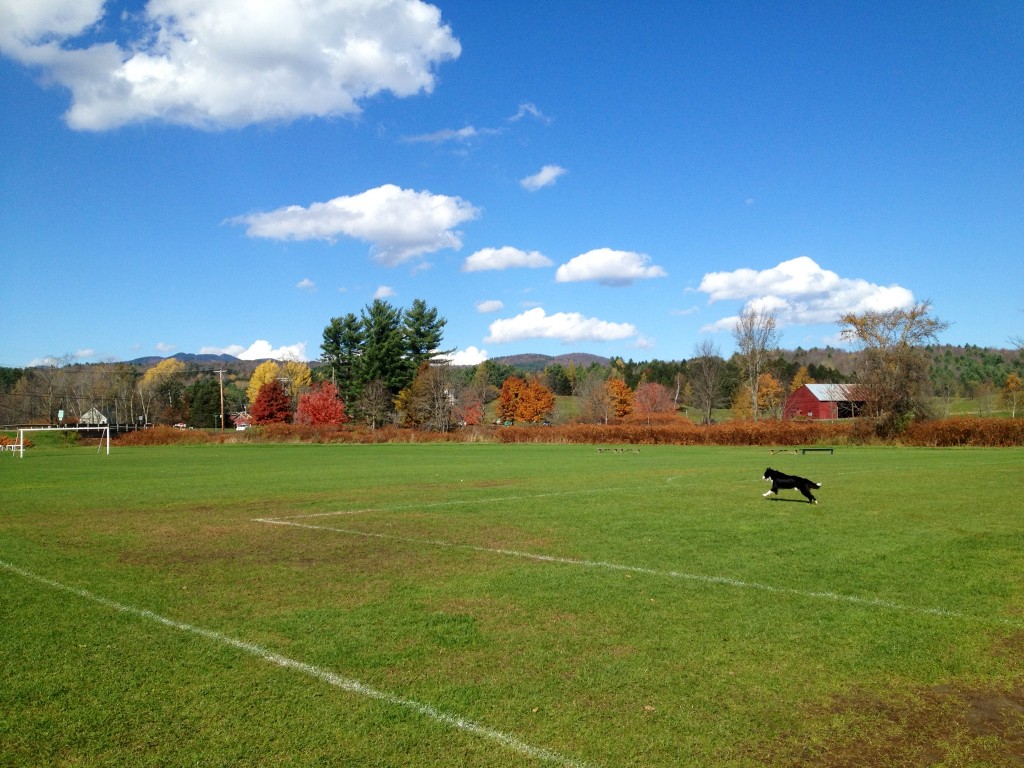
We found a great open field where Tuck enjoyed a few rounds of fetch before joining in play with a couple of local dogs. Then we pressed on to the West Branch River, where my dog got his fill of fresh spring Vermont water.
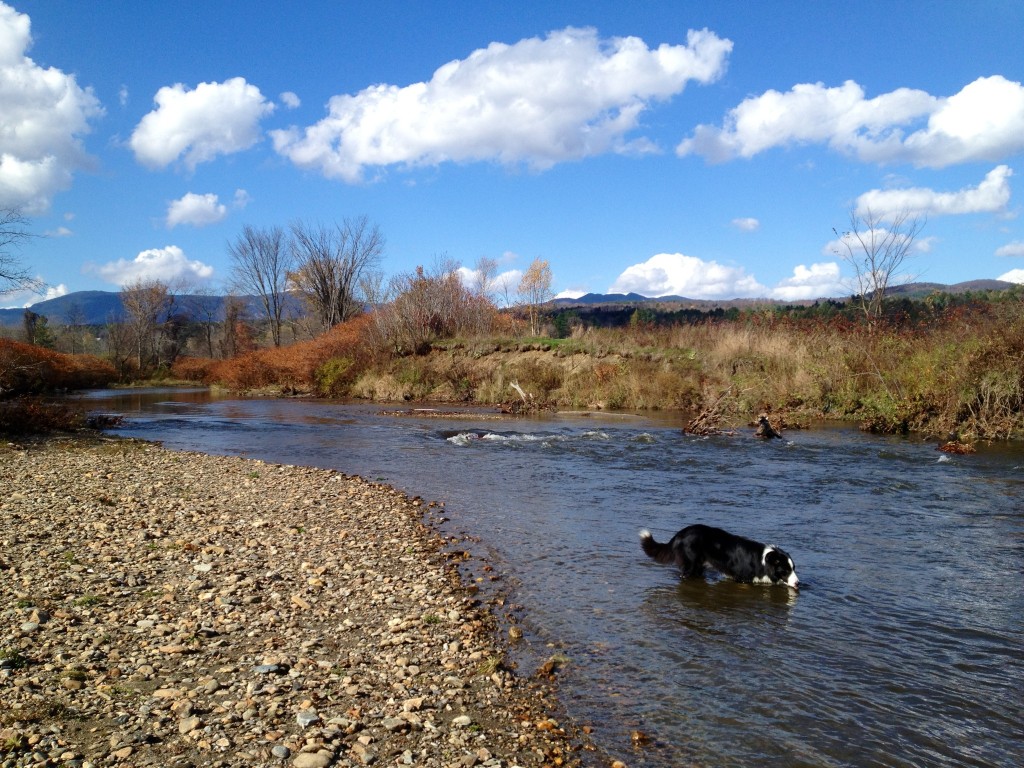
From Stowe, I began to head east toward Maine on Route 100. I had to pull off, however, when I passed the Rock Art Brewery. Here I had the friendliest tasting of my Vermont brewery tour, and I really enjoyed their Jasmine Pale Ale.
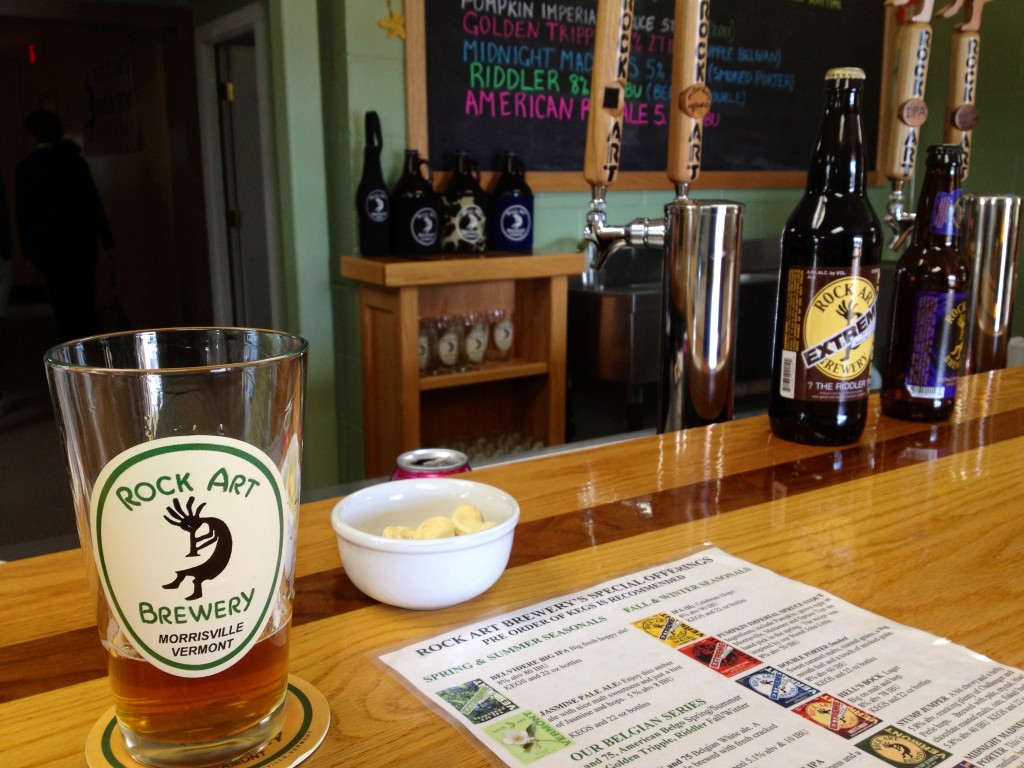
But I had my eyes on a bigger prize, one to be found way off in rural Greensboro, Vermont up a rutted gravel road in an area that looked so desolate I was sure I was lost: Hill Farmstead Brewery, home of what some consider to be the best craft beer now being made in the United States. Once again, thanks to Brad for the hot tip! I knew not of the brewery before I arrived, which I believe led to less tasting bias than more knowledgeable beer freaks may possess.
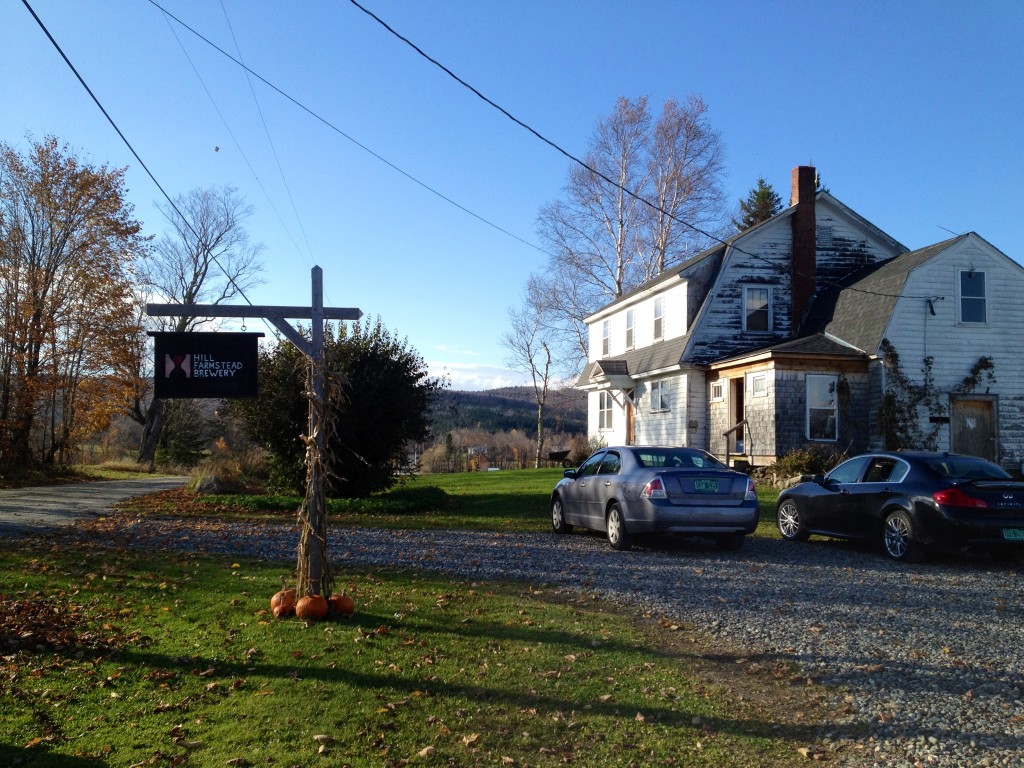
Any Google search will fill you in on the Hill Farmstead backstory, so here’s my experience. The brewery is basically a converted garage attached to a ramshackle homestead on the top of a hill surrounded by wild Vermont mountains. When I arrived, the parking lot was full and people were queued four or five deep at the taps set up in the corner of the garage. All were there for tastings or growler refills or a glimpse of Shaun E. Hill, American craft brew wunderkind, as he washed glasses and worked the taps. Some of the stories I’ve read have even gone so far as to dub Shaun the best brewer on the planet. High praise for a brewer in his early thirties, but would the beer live up to the hype?
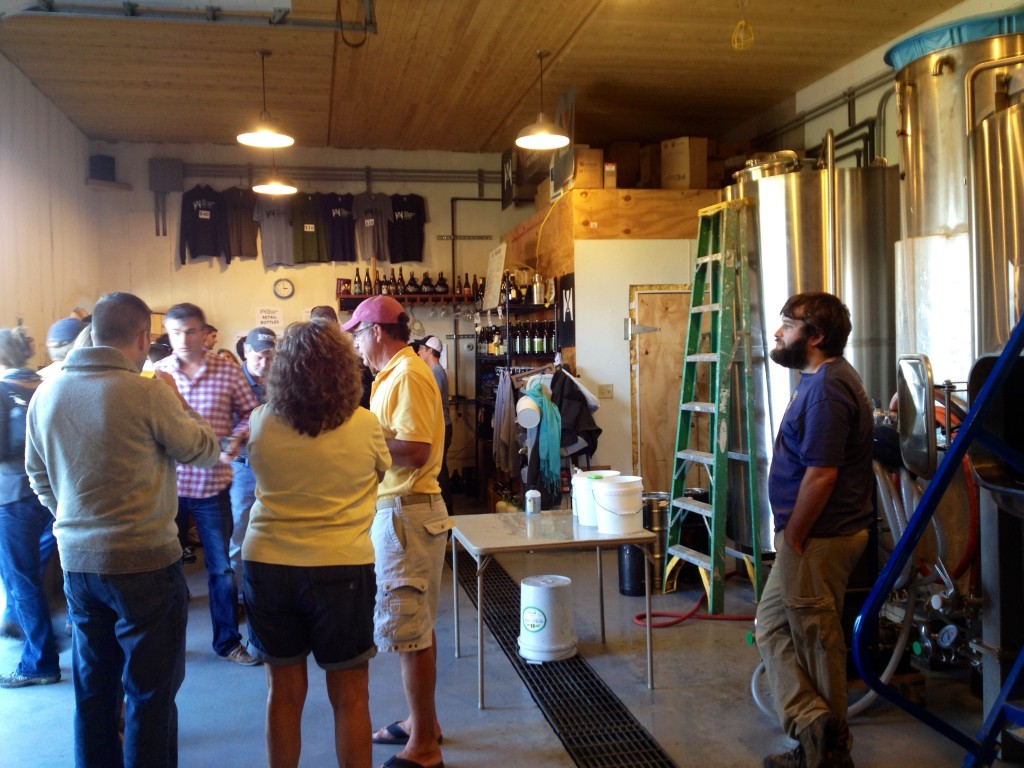
I had four samples of the six on tap, and couldn’t find fault. The two that I liked best were Abner, the double IPA, and Holger Danske, a smoked brown ale. Hill Farmstead has neither of these beers in bottles, and very, very limited distribution outside of Vermont for a few of their other offerings, so the best and often only way to enjoy these beers is from the source.
Abner and Holger Danske were two of the best beers I’ve ever had, and exhibited taste profiles that were complex and changing yet perfectly smooth, with a range of flavors that were beautifully balanced. I won’t go into more beer geek descriptions, which are widely available online if you’re interested. However, I encourage you to head up that hill and taste for yourself. You won’t regret the trip, but be forewarned that once you taste Hill Farmstead’s offerings you may be left with a craving that’s hard to fill with whatever you’ve got available in your local supermarket. I know I’m ruined.
It was with a sadness that I pointed my car toward New Hampshire, assuaged only by a couple of 750 ml. growlers of Abner and Holger Danske keeping company with the Heady Topper in my cooler. As the Hill Farmstead beers were fresh and not bottled, I knew I had just a couple of days to enjoy them—an event to which I looked forward even as I mourned finding beers so delicious and yet so unattainable once I returned to my life in Virginia.
October 23rd, 2012 §
I pulled up to the Topnotch Resort in Stowe in, you guessed it, driving rain. Though the valets were incredibly sweet and well-intentioned, when one is living from one’s car, with a dog, it’s not the easiest thing to just toss my designer hand luggage to the bellman and allow someone to whisk my car away. With a bit of negotiation I managed to retain my keys so I could visit my car for dog food and to check on the well-being of my Heady.
Topnotch is a truly pet-friendly resort, and I was encouraged to take Tucker with me to the check-in desk. He was keyed up from a rainy day spent in the car, and wanted to greet everyone who walked by. I was relieved when we got to our room and I could finally unsnap his leash.

There I found a nice bag of dog treats and a card addressed to Tucker from the resort’s concierge, as well as a dog bowl and plush shearling dog bed, which he tried out right away. Pretty swank for this soaking-wet pooch who’s rejected the three dog beds he has at home!
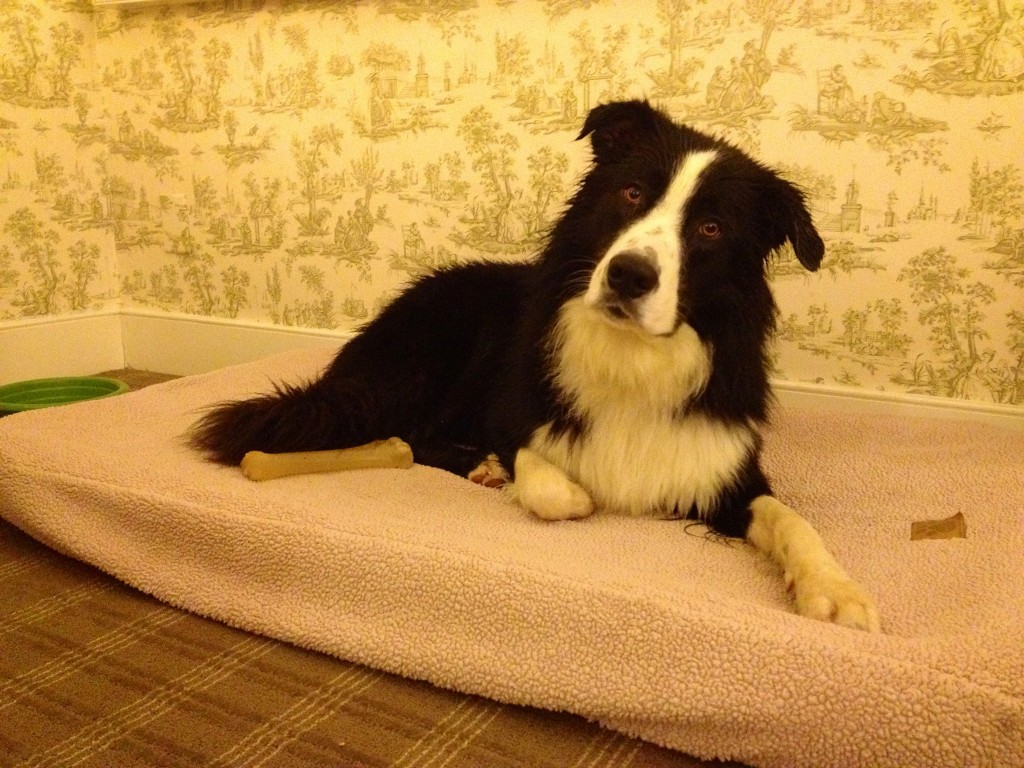
The best part of Topnotch to me, other than the wonderfully decorated and comfortable room, was the water complex. I quickly changed in to my bathing suit and hit the indoor hot tub, which had a waterfall feature that beat my driving-tired shoulders in to relaxation. I took a dip in the indoor pool, read a bit of a magazine, and then headed outside in the rain to swim in the heated outdoor pool.
It was dark, and cool above the water. But as I dove I could see the silvery undersides of myriad raindrops shattering the water’s surface. I swam laps and then dove, flipping over and over in handstands. It was the first time I’d relaxed in the water in years. I was in a pool only once this summer and it was to pull tree branches out of my parents’ pool after the June 29 derecho. Not exactly a recreational dip. And so, on this rainy night in Stowe, I played.
When I’d worn myself out, I headed back to my room and snuggled in to a hotel robe. I ordered room service, and Tucker got his first taste of the sweet life when I gave him the leftover broth from my mussels. Then I turned on a t.v. that seemed almost as large as I, snuggled in to one of the comfiest beds I’d ever experienced, and relaxed…until it was time to take Tucker out for his before-bed walk, which we did in the rain and both ended up soaking. Nothing like a dog for keeping it real.
Nonetheless, wonderful sleep followed, and I started the next morning by taking my tea while soaking in the outdoor hot tub.
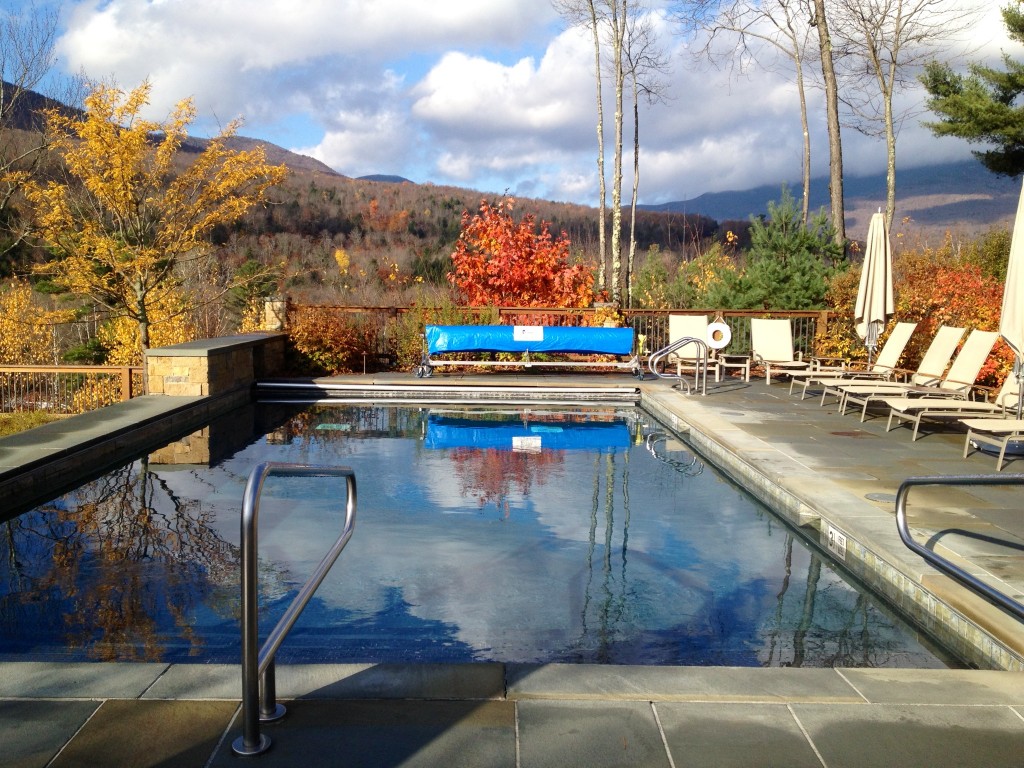
The rain had cleared, and mountains that were shrouded in fog the day before sprang in to view all around the outdoor pool complex.
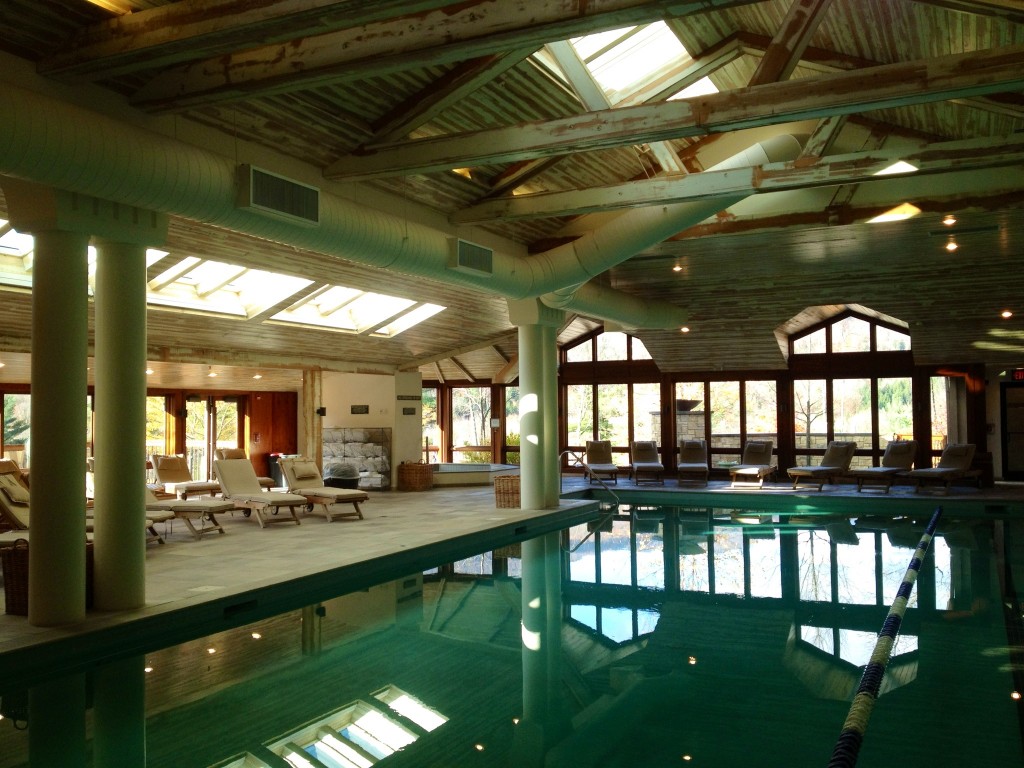
After a few laps in the indoor pool to cool off, it was back to pack up the room and hit the road. I wasn’t the only one who didn’t want to leave!
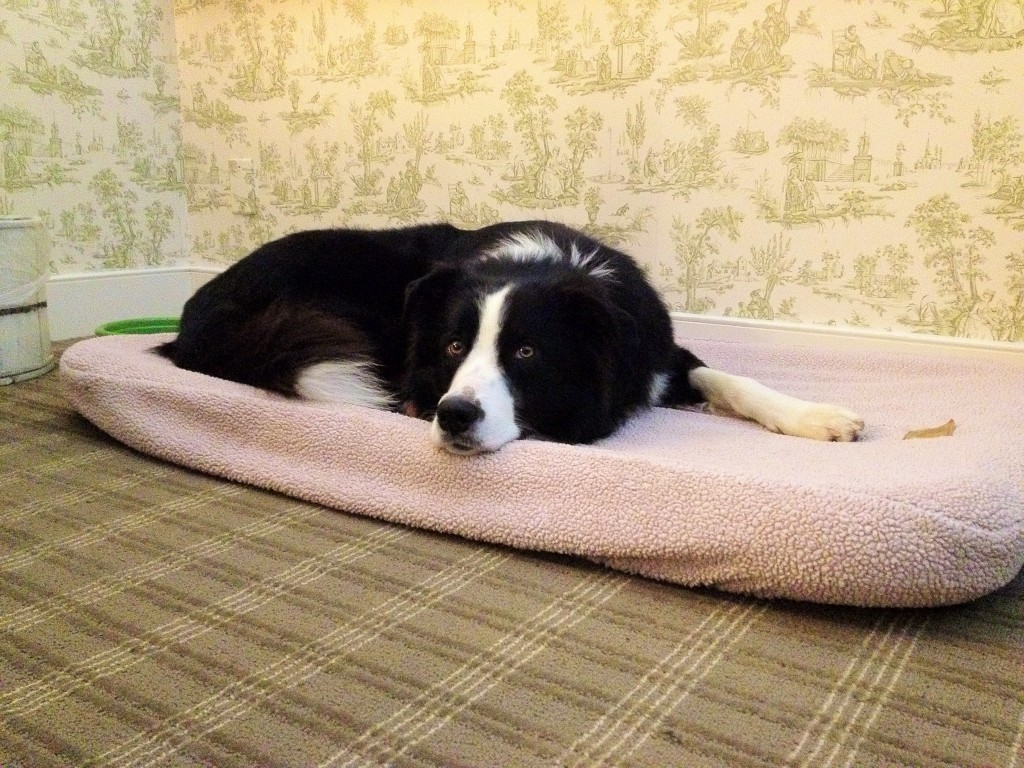
October 23rd, 2012 §
After more than three hours of wandering the Shelburne Museum, my feet were tired and my mind was buzzing with everything I’d seen. Though I wished I had the stamina to return for a second day, I pressed on toward Burlington, Vermont. I soon came across the Magic Hat brewery, and even though I think their beers are mediocre—and a six pack of their Oktoberfest I bought before my trip was the first beer I’ve every purchased that was skunked—I couldn’t resist a tour.
Once inside I was immediately overwhelmed by what felt like very forced “arty” kitch. The tasting bar area was decorated in neon and graffiti and steampunk mechanical madness. There were a bunch of frat boys standing around, and I had to fight my way through them to be noticed. I zeroed in on the only female bartender, who was very nice as she poured my samples. As I was drinking a boy, a economics student from the University of Vermont, took it upon himself to educate me about beer. His opening gambit was that he recommends lighter beers “for women.” No sooner was it out of his mouth than I was ordering the smoked porter. He looked suitable chagrined and beat a hasty retreat, but I was sickly comforted that, at more than a decade older than he, I was worthy of being looked after at a beer tasting.
I went ahead with the guided tour, and what struck me most was that the founder of Magic Hat, Alan Newman, definitely appears to be a pretty cool counterculture freak and yet has created not only a successful brewery but also several other companies, including Gardner’s Supply and Seventh Generation, which should ring a bell for anyone who’s ever searched for eco-friendly dish or laundry detergent. But none of his original passion came through in my tour. My experience at Magic Hat demonstrated to me that it was a company at at tipping point…in theory they espouse the artistic and personal freedom of their founder and yet have very much played into a corporate mindset pushing “fun” as their commodity (my bartender told me that the best way to make sure a trial beer makes it to bottling is to make a ruckus their Web site and social media).
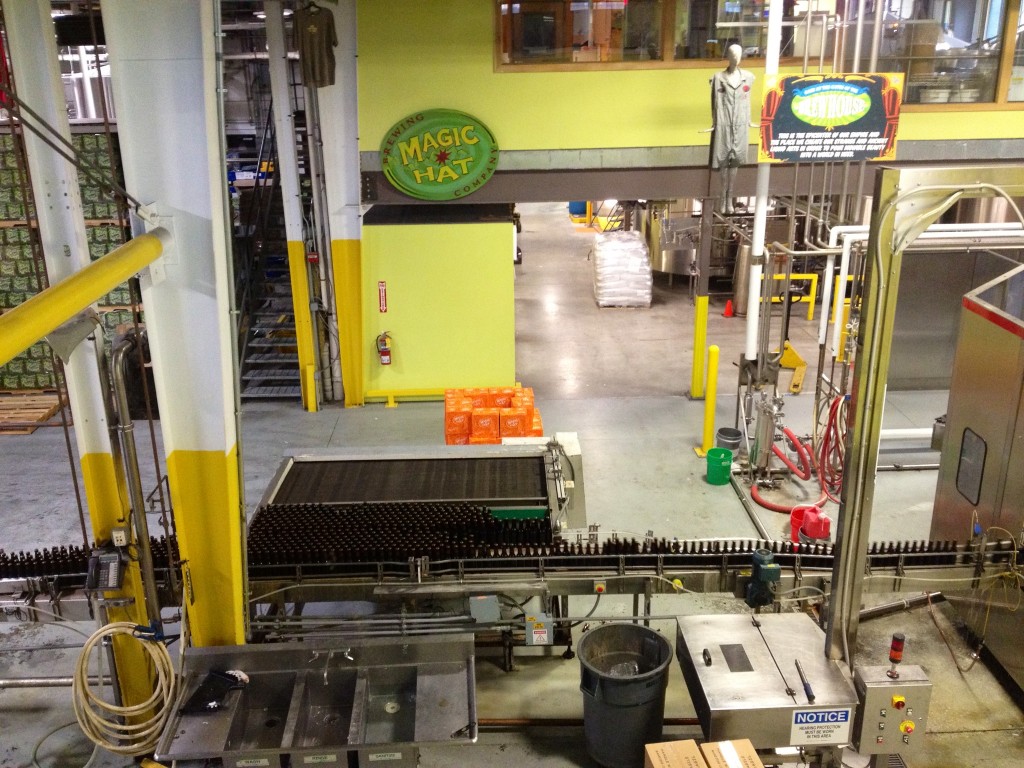
I left feeling a bit like I’d been run through an amusement park, the most interesting part of which was not the beers, but the production line.
I continued up the road, rolling in to Burlington as the sun was setting. I saw the makings of a good photo op and dodged this way and that through their town center to the waterfront. It was truly beautiful…a colorful sunset over broad water ringed with purple mountains.

As the light faded from the sky, I headed back up the hill and picked up a chicken curry falafel from a storefront near the center of town. I found a bench on the Burlington pedestrian mall, which reminded me a lot of Charlottesville’s, and ate while watching a live band. I strolled the mall, stopping in to a neat bookstore where the proprietor looked like a hotter Jason Bateman, and then it was time to find a place for sleep for the night.
Friday dawned showery and with a full rainbow over my motel. It didn’t look like good weather for exploring Burlington, so decided to hit the road. By the time I’d gotten the car packed, it was starting to rain. I stopped in to a liquor store near the hotel looking for Heady Topper, a local beer made by Alchemist and recommended by my friend Brad. They were sold out. So I figured why not head up to the brewery and pick it up from the source? I merged on to I89 headed toward Waterbury with the intention of stopping at Alchemist and then heading toward Maine.
Immediately it started to pour buckets. The rain was sheeting across the highway, and my SUV was being blown too and fro. I couldn’t see a carlength in front of me. I don’t normally mind driving in bad weather, but I was on vacation with no timetable or set destination and wanted to avoid stress at all costs. So I made it to Route 100 and pulled off, ducking in to the Alchemist Brewery just before 11:00 a.m.
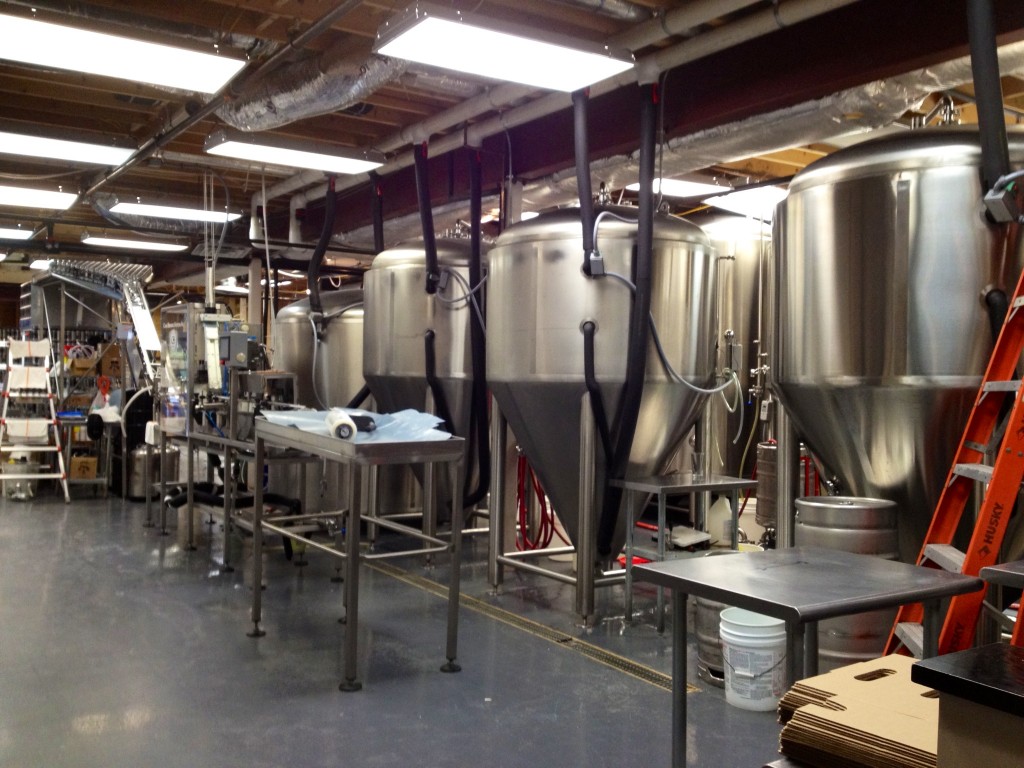
Alchemist is a brewery that focuses on one beer, the Heady Topper IPA. It’s a beer that’s heavily hyped and has its own cult following, so much so that even locals acknowledge it’s hard-to-come-by. With a Beer Advocate score of 100, it’s known for waves of smooth hops flavor. I had a taste, looked in on their small brewery, and walked out with a case. It was a Friday morning—the brewery isn’t open on weekends—and traffic was steady in and out of the place with massive amounts of money and silver cans changing hands. The woman who poured my tasting told me that they would sell out for the weekend in a couple of hours on a Friday morning, and that Heady Topper lasts only between 16 and 24 hours on the shelves in a few Burlington stores before it’s gone.
Case secured, I promptly went to the nearest supermarket and bought a bag of ice and loaded the beer in to my cooler. I felt like I was transporting an organ—this beer is so fresh and nonpreserved that it had to remain cool all time. And then I tasked my trained guard dog with protecting our haul.
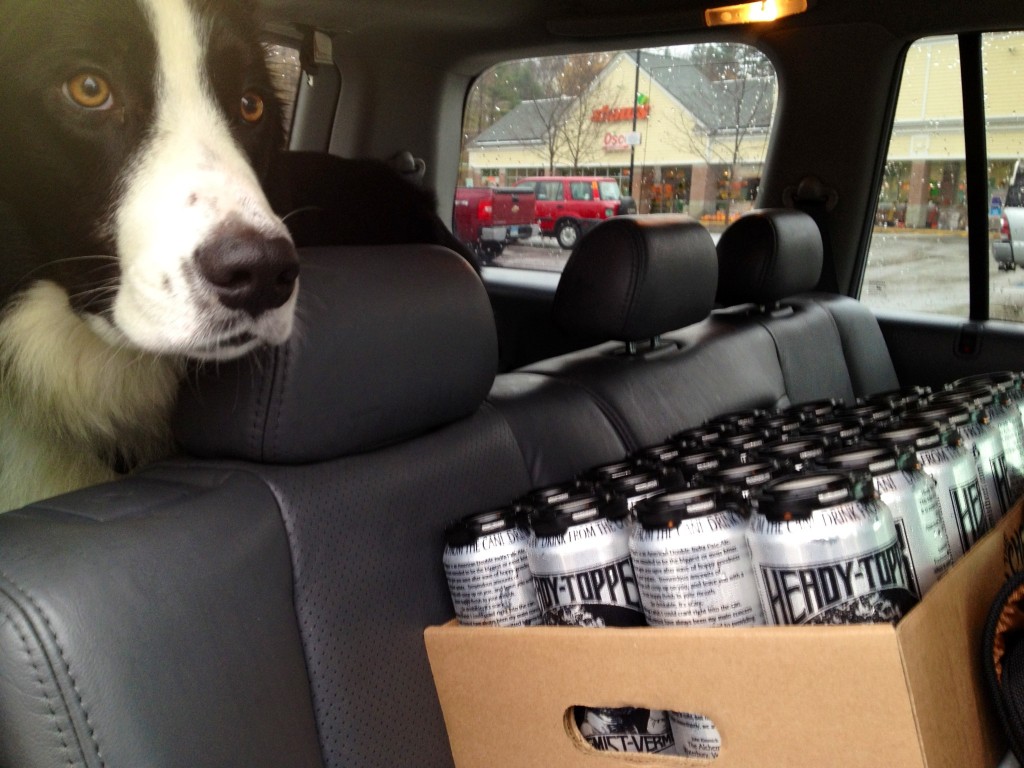
It was still pouring rain, and the Ben and Jerry’s factory was nearby. Though I am not a huge ice cream fan, I needed something to do other than drive, so I took their tour. It was interesting only in so much as our guide was forced to elongate every “o” she said to sound like a cow. For example, “Let’s all moooove over to the production area, where you will see we are packaging a heath bar ice cream today.” Poor girl. We had samples of Late Night Snack at the end of the tour, and it wasn’t bad for an ice cream that features chocolate-covered potato chips.
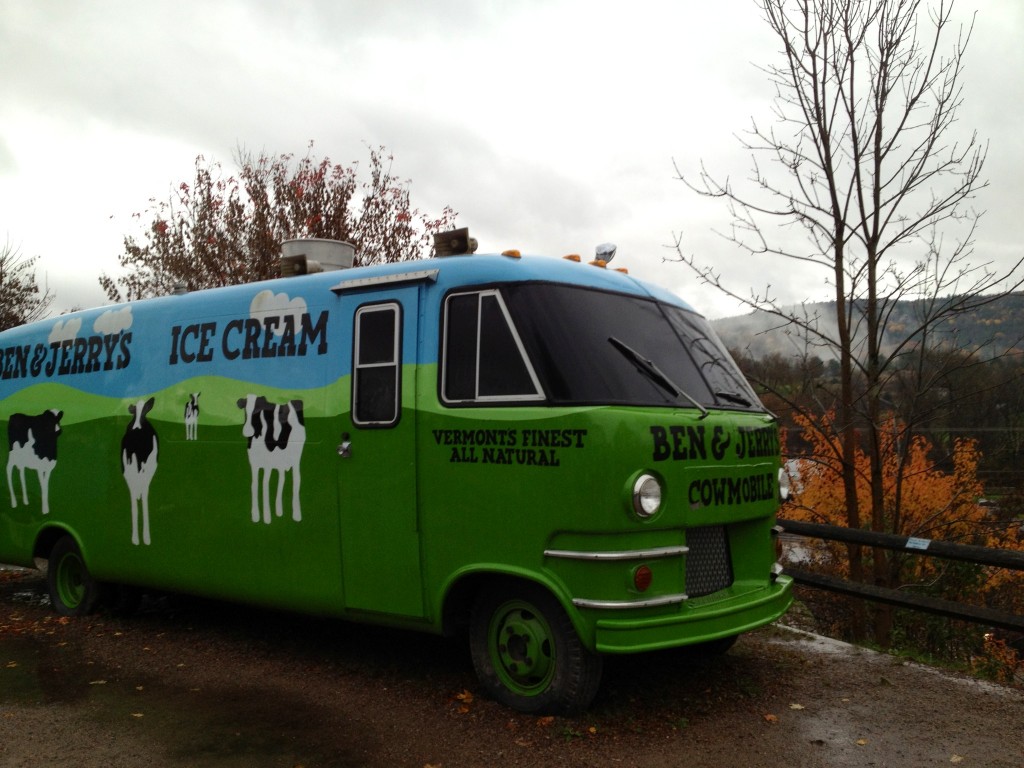
Just as at Magic Hat, I was struck by the starting visions of Ben and Jerry’s founders, who got their start dabbling in something they found interesting. They learned how to make ice cream from a Penn State correspondence course, and now they have a thriving corporation that was acquired by Unilever. To hear stories such as theirs gives me hope that pursuing my interests may one day lead to the career of my lifetime.
It was still raining after the tour, and I didn’t want to waste my drive through the White Mountains if I couldn’t see anything. I started calling around for hotels. The Topnotch Resort and Spa was pet-friendly, so I booked a room there and decide to hole up and wait out the weather. While my room was being prepared, I had a great smoked turkey sandwich at the Prohibition Pig in Waterbury, along with a half of Heady Topper and another of Lawson’s Finest Maple Nipple Ale. Then I wandered into a lovely little bookstore nearby, Bridgeside Books, where I picked up a few cards and a 2013 calendar and had a nice chat with the proprietor.
By then it was time to head up to Stowe and check in to Topnotch and get out of the rain!
October 22nd, 2012 §
And so we resume our tour of the Shelburne Museum:
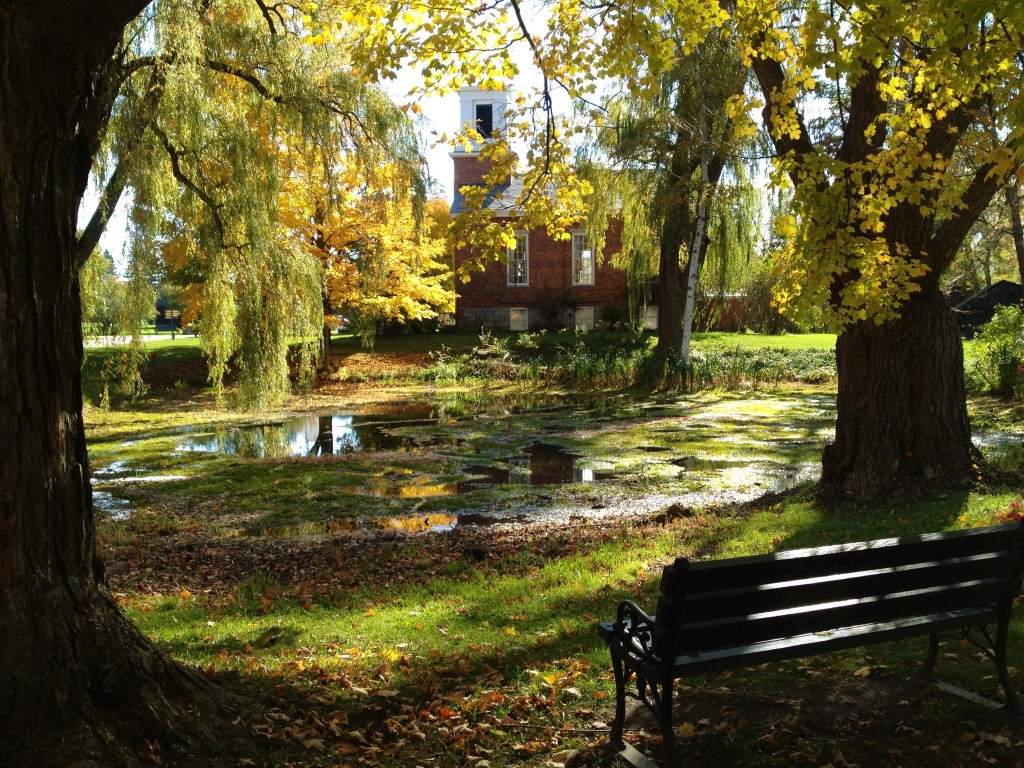
I went in to a huge post-and-beam barn filled with all sorts of carriages and wagons, including an old hearse and a Conestoga wagon. I was really struck by the typography on this ferry wagon. I found it incredibly skilled and beautiful:
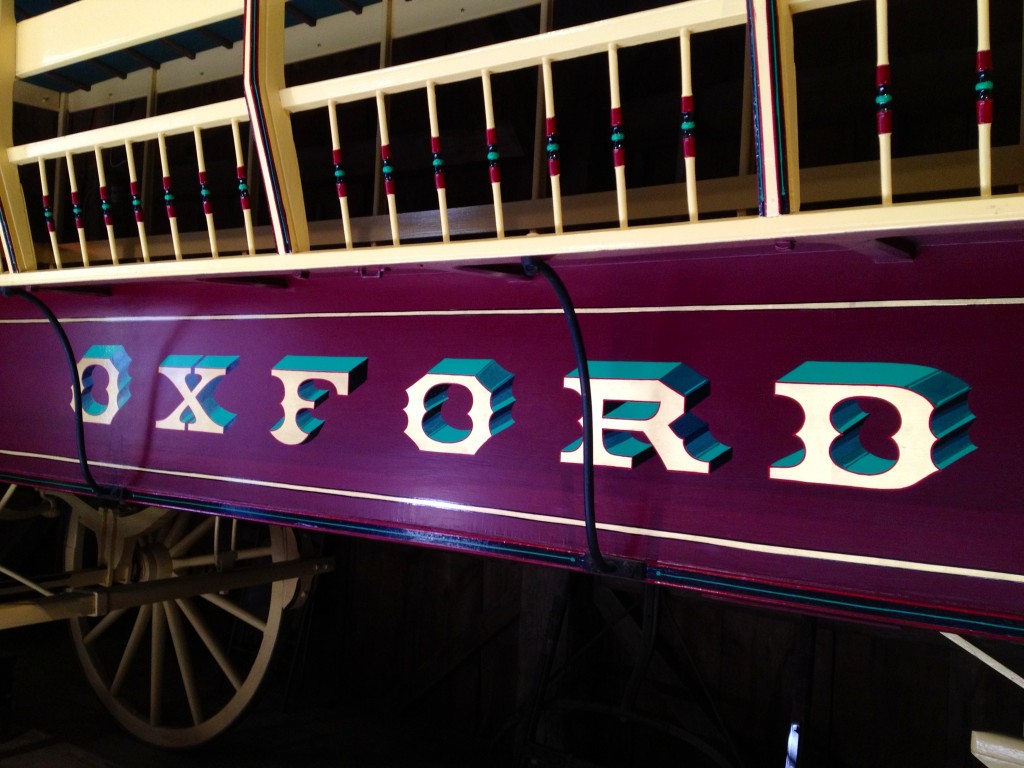
With just paint, the artist managed to create a complexly shadowed, gilded letter that mimicked malachite. This is one of the most striking pieces of typography I’ve ever encountered and, sadly, my iPhone photo doesn’t do it justice.
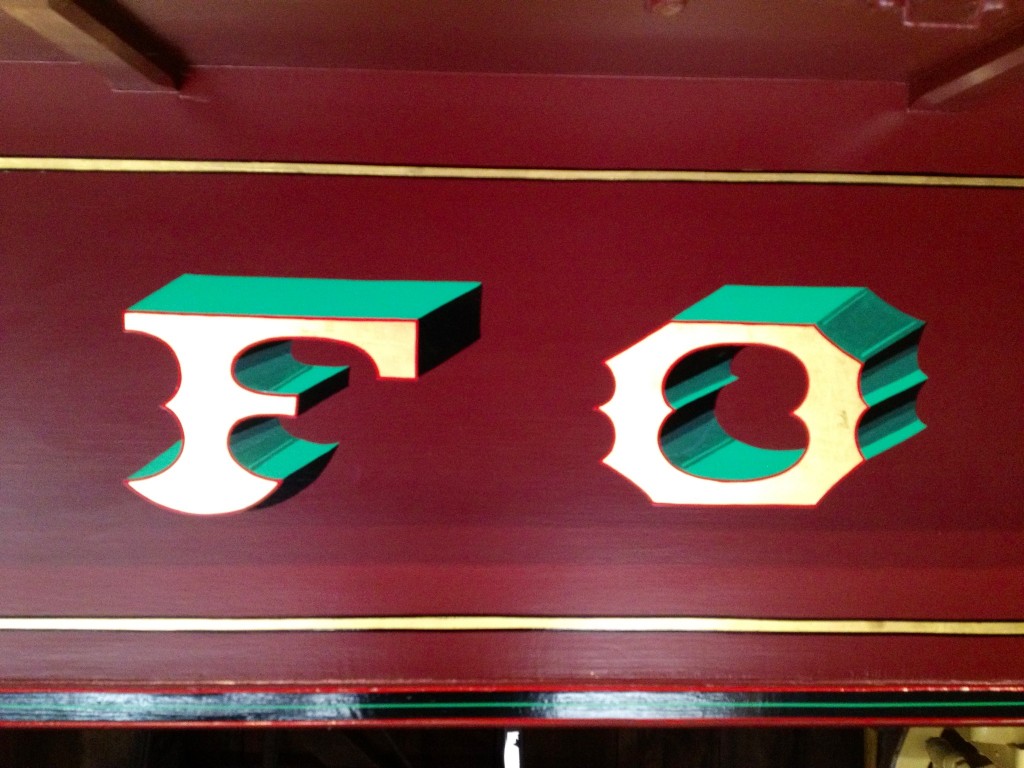
Next I went on to the printmaking barn, where I got to try my hand at letterpress. And then on to the weaving barn, where beautiful looms made me want to learn how to weave. I took a weaving course in my second year of college, but it was more art-based than practical, and I think I would enjoy weaving more knowing I was making something I could wear instead of a hippy-dippy piece of dubious “art” to hang to hang on the wall of my opium den.
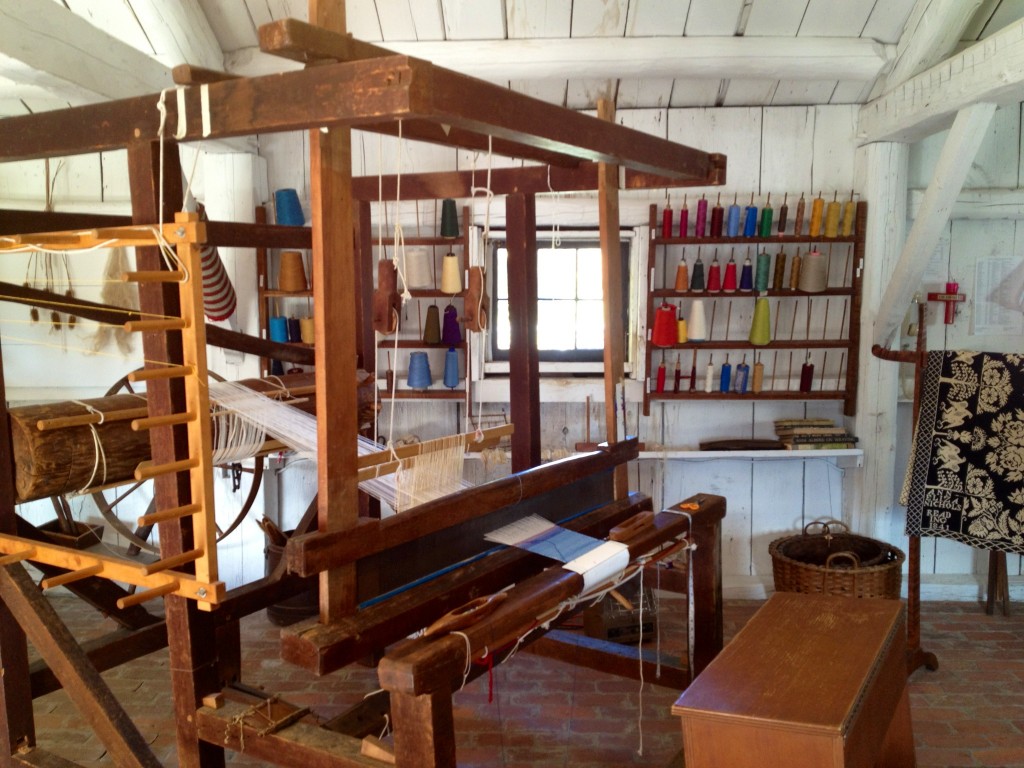
Another graphically impressive exhibit was in a huge long barn that was hung floor to ceiling with old tools. Here’s just a chunk of one wall, with some wood planes in the foreground:
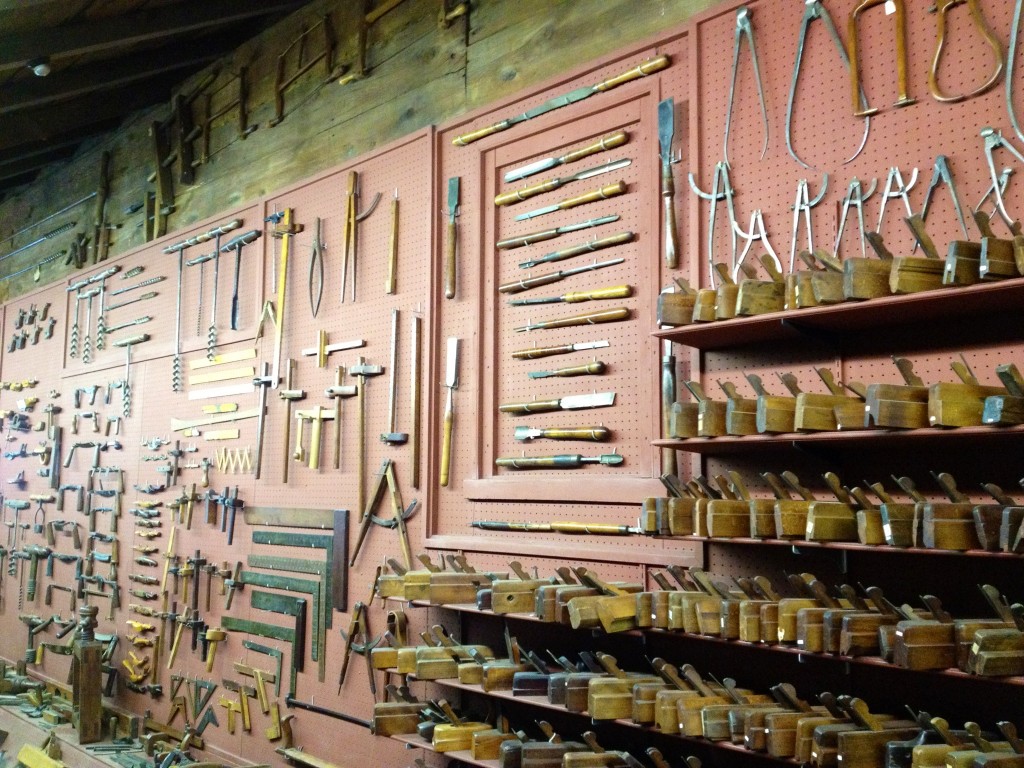
The other side of this barn featured iron work, including many boot jacks. I got a laugh at these pornographic examples, tactfully displayed near the floor behind a low wall to protect the innocence of any visiting children.
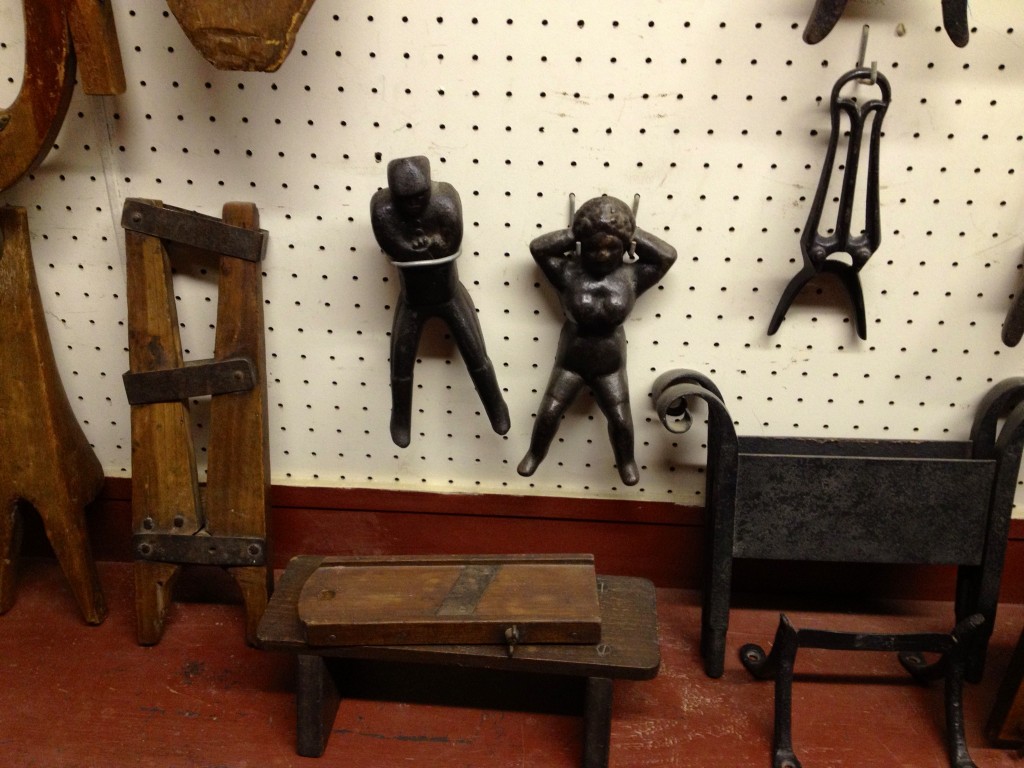
There was an entire house (!) devoted to carved wooden bird and fish decoys. All were beautiful, and I took this picture for my mom. See, Mom, carved wooden swans are art!
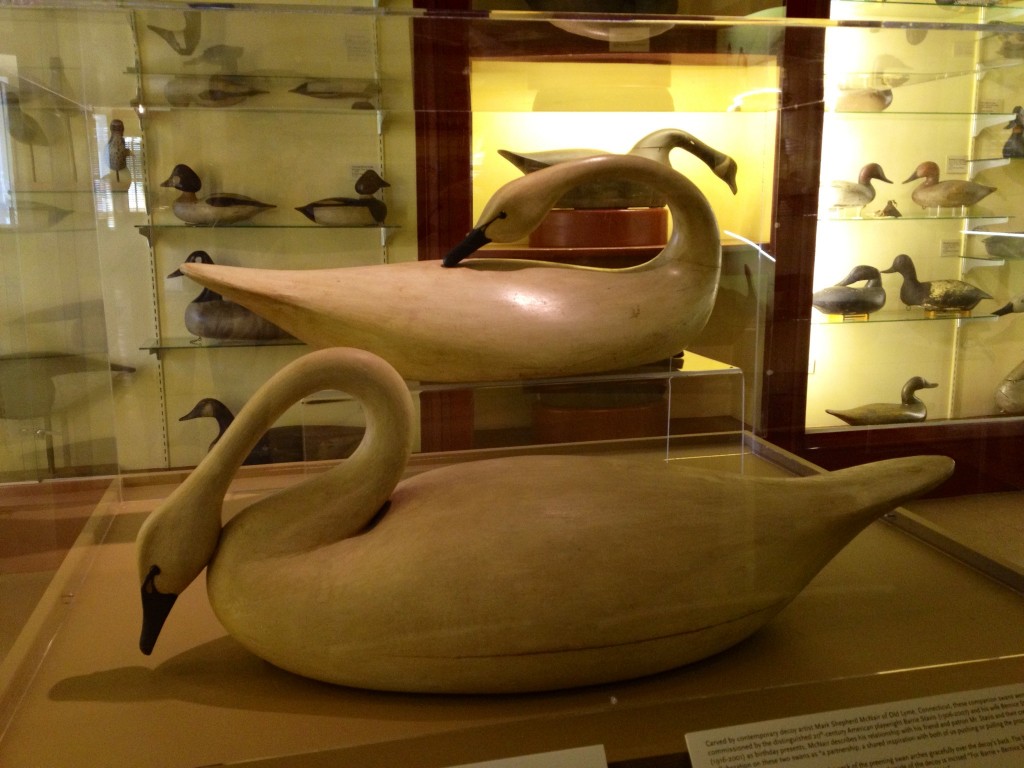
Next I went in a few historic homes and log cabins, marveling all the while at how little space people need to live. I learned this lesson first-hand when I spent a few months in a small, one-room cabin in Alaska that was only accessible by boat or float plane, but it was nice to be reminded that the home I have now is, at 2,100 square feet, a relative palace. I guess when you don’t have a lot of crap you don’t need much room to store it, right?
Being on the road for the past ten days has further cemented my inclination that one doesn’t need a lot to live well. This is an idea I’ve danced around in various ways, beginning with my college ramblings and including my time in Alaska. But due to a recent major life change the question of how far I can pare down has resurfaced. This trip is confirming to me that I still possess a gypsy spirit and no desire to measure my success by how much I accumulate. In fact, I feel the inverse. It’s not a radical idea, but the less I possess the more freedom I feel. Even without my comfortable home and land in Free Union, which are a gift and blessing, I feel rich beyond measure with only a working vehicle, enough money to gas up the car, a small bag of clothes, a couple of pairs of boots, my beautiful dog Tucker, and a cooler full of Heady Topper.
Up next: Burlington and the Vermont brewery tour continues!
October 21st, 2012 §
I was really excited to visit the Shelburne Museum because it features all sorts of things that I dig. Folk and decorative art, textiles, handcrafts and much more are on display in a collection of historic buildings, some of which, such as cabins and a lighthouse, had been relocated to the museum grounds.
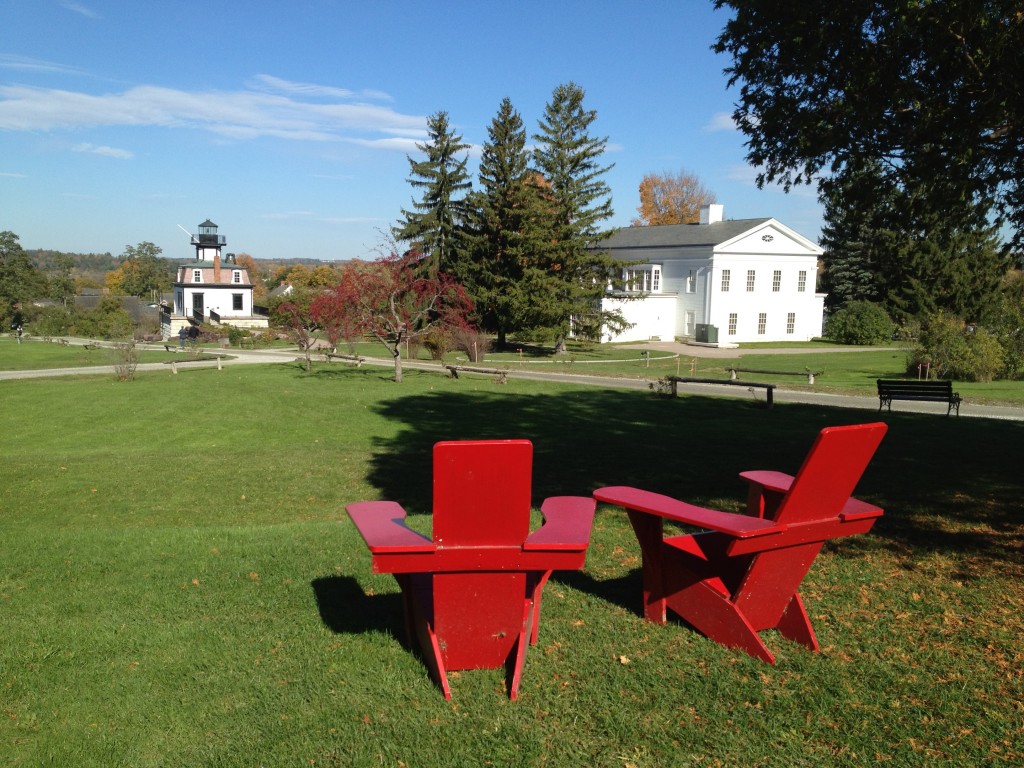
There’s also a beached steamship, the 220-foot Ticonderoga! It was neat to wander its four levels and be reminded of how classy travel used to be. The interior was fitted with carved wood trim and leaded glass, and most surfaces were plush with upholstery. There were only five overnight rooms on the ship, but to peer in to them I shared the excitement that their occupants must have felt on their adventures. I am on an adventure too!
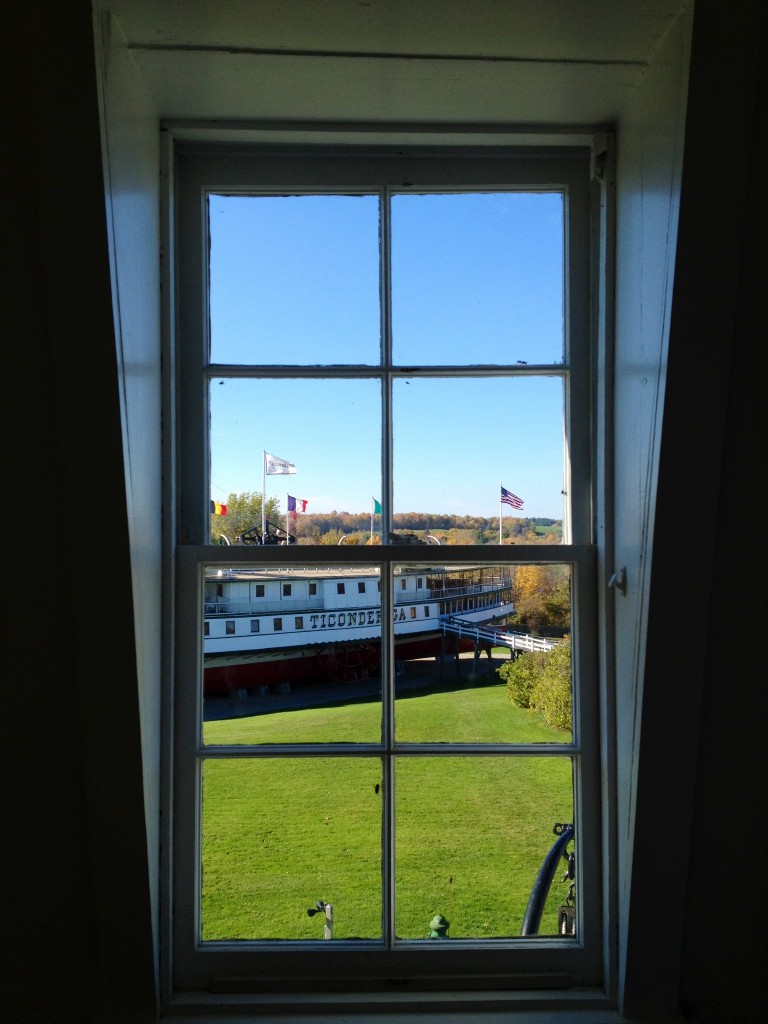
I was particularly taken with the beauty of this 80-foot-diameter round barn. According to the museum:
It is one of only two dozen built in the state [and] was constructed in East Passumpsic, Vermont in 1901. Round barns, designed for economy of labor, were first built by Massachusetts Shakers in 1826 and re-introduced by a national farm magazine in 1896.
The Round Barn was moved to the Museum in 1985-86. The 9,000-pound upper segment of the silo was flown across the state by helicopter, while the remainder was dismantled and moved on flatbed trucks.
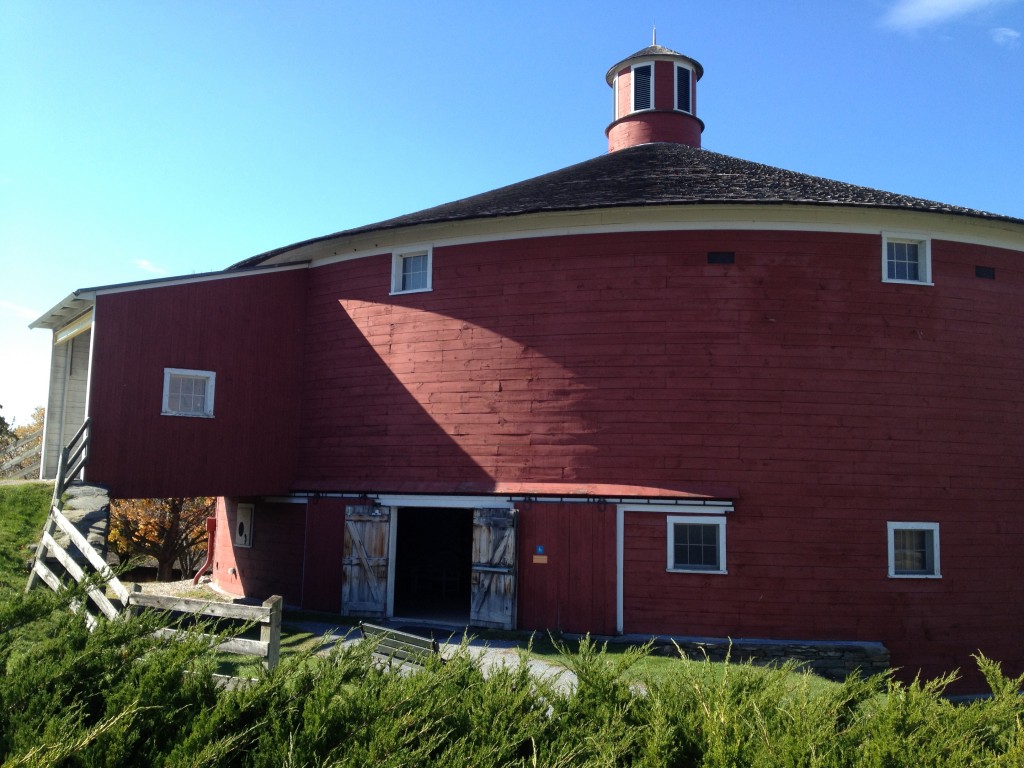
The reconstruction was obviously done by skilled artisans, as evidenced by how the siding was scribed to the rock foundation. I thought that level of care and attention was pretty impressive!
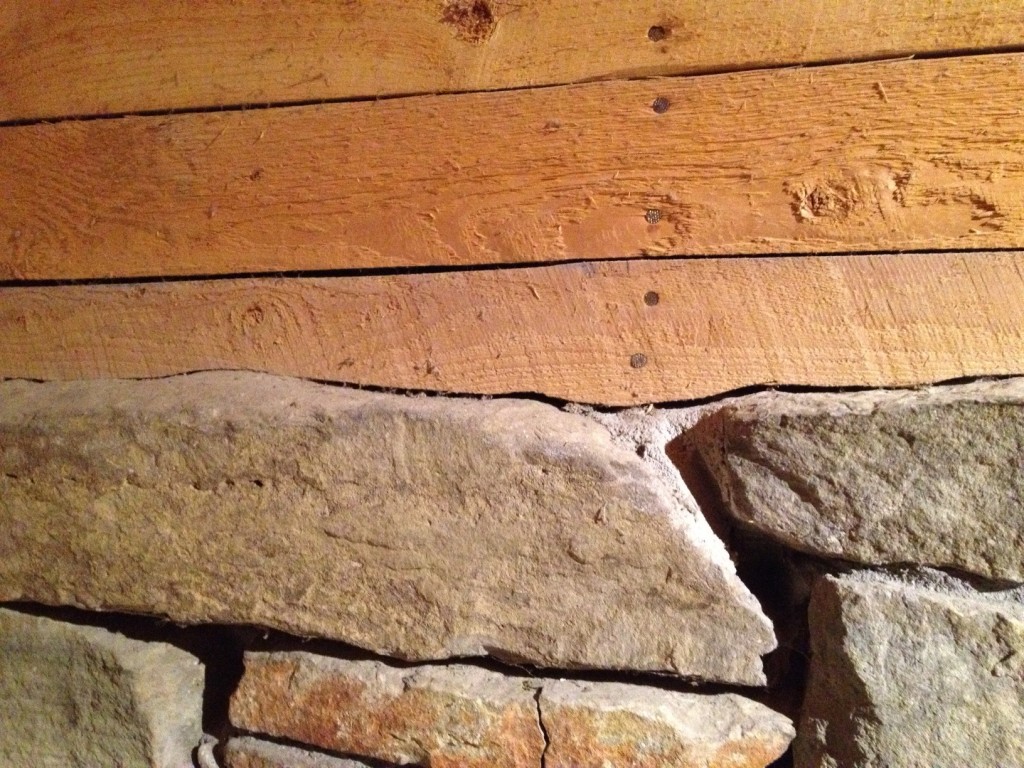
One of my favorite exhibits was the apothecary, which was housed in an old general store building. I was struck by two things: one, how simple and beautiful the space was. It made modern drugstores look like psychotic temples to the twin gods of hypochondria and consumerism. Imagine the last time you went in to a store where there was only one item to cure your particular complaint—I bet you can’t. To my overloaded-with-choice modern mind, this limiting of options seems relaxing.
But I can imagine it from the other side too—and I can see how appealing new products, even if they were snake oil, would have been to people who in theory will always value choice so as to better exercise their individuality.
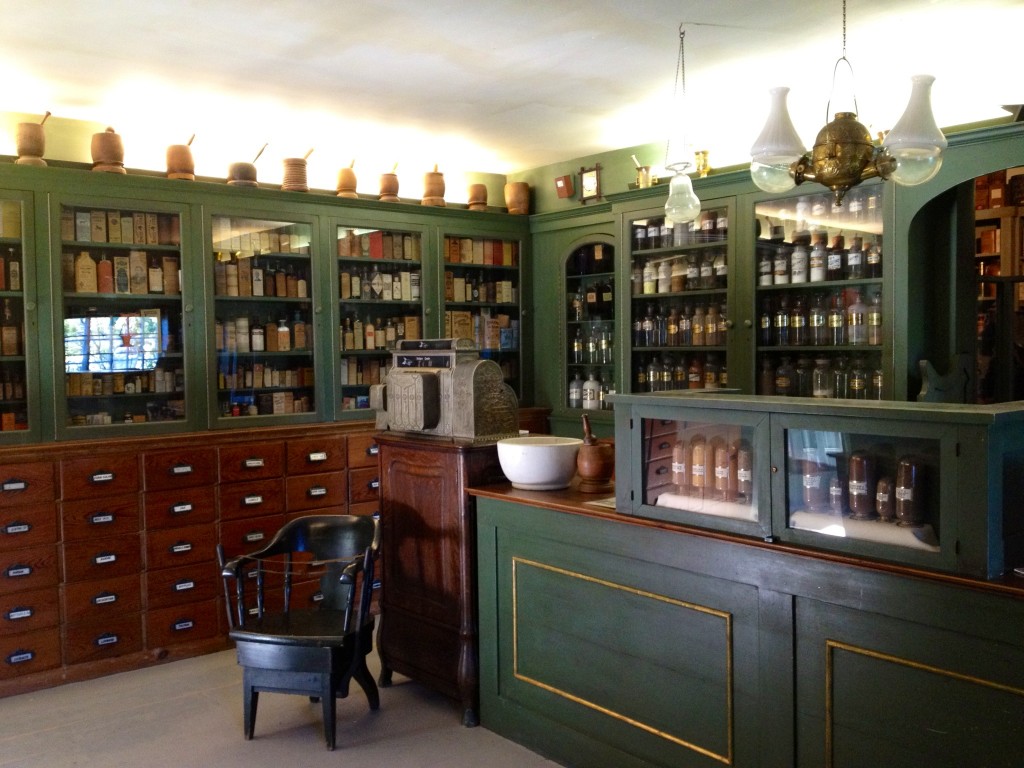
After taking a herbalism course last year, I was fascinated to see that so many of the remedies in this apothecary were plant-based. I am very familiar with many of the plants I saw, including skullcap, which I’ve relied upon heavily in the last couple of months to ease tension and quiet my racing mind, and arnica, which I liberally use in a cream for bruises and sore muscles.
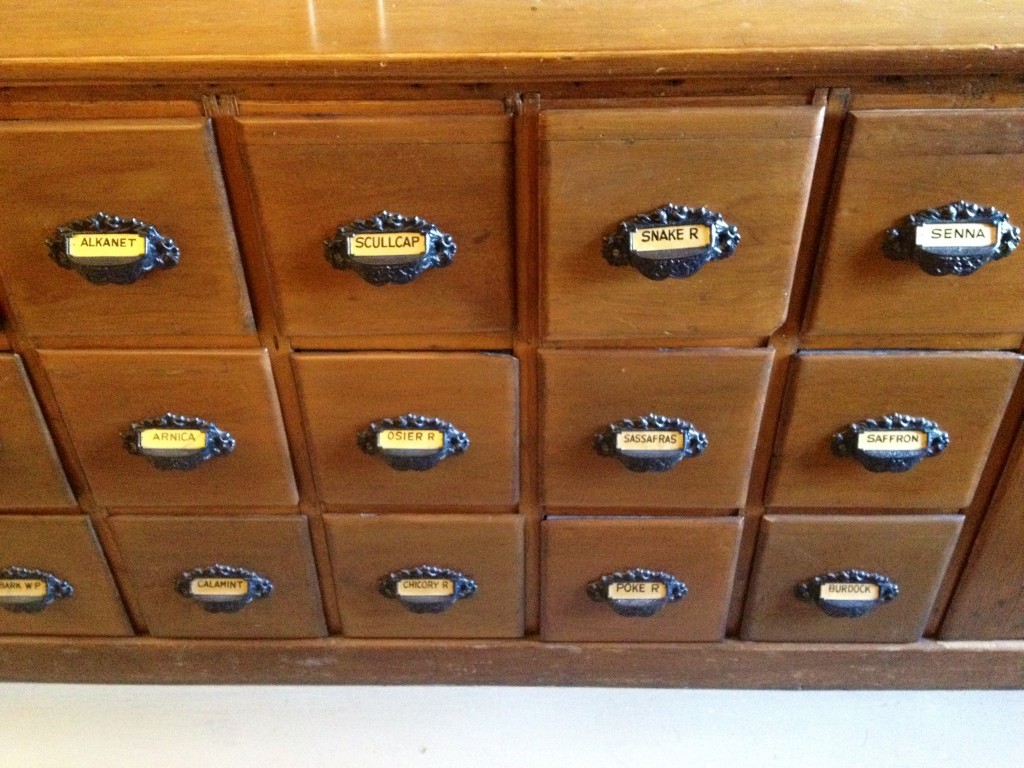
The original pharmacist’s counter:
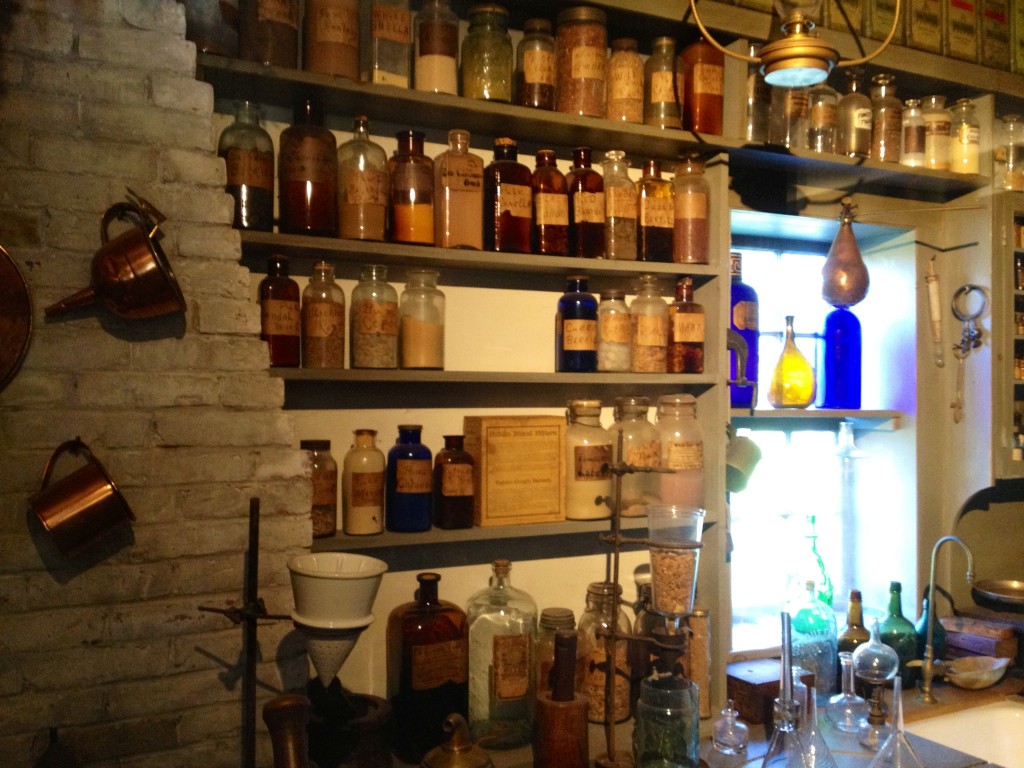
What you can only make out part of is the chimney to a hearth where medicines were prepared. Looks a lot like a kitchen, doesn’t it? Seeing this set-up reminded me of some of the speakers I’d heard at the Mother Earth News Fair, as well as my herbalism teachers, and my mom, who in their own ways drummed in to my head that “food is medicine.” I’m totally on board with that idea, but that’s a topic for another post.
Up next, we’ll continue our Shelburne Tour and then head to Burlington for a gorgeous sunset over Lake Champlain!
P.S. This is post number 300 on the Bonafide Blog. Three hundred seems like a big number to me, and I’m proud of myself to have made the time in my life to write about what’s important to me. Just as it takes time to create this blog, it takes your time to read it. And I thank you for following along! Four hundred, here we come!
October 20th, 2012 §
Thursday morning I picked up a goat cheese and watercress sandwich from the Otter Creek Bakery in downtown Middlebury, Vermont. I ate half of it while wandering the small downtown area, which included a neat bookstore, the independent-since-1949 Vermont Book Shop, as well as an establishment smelling heavily of patchouli and alpaca sweaters.
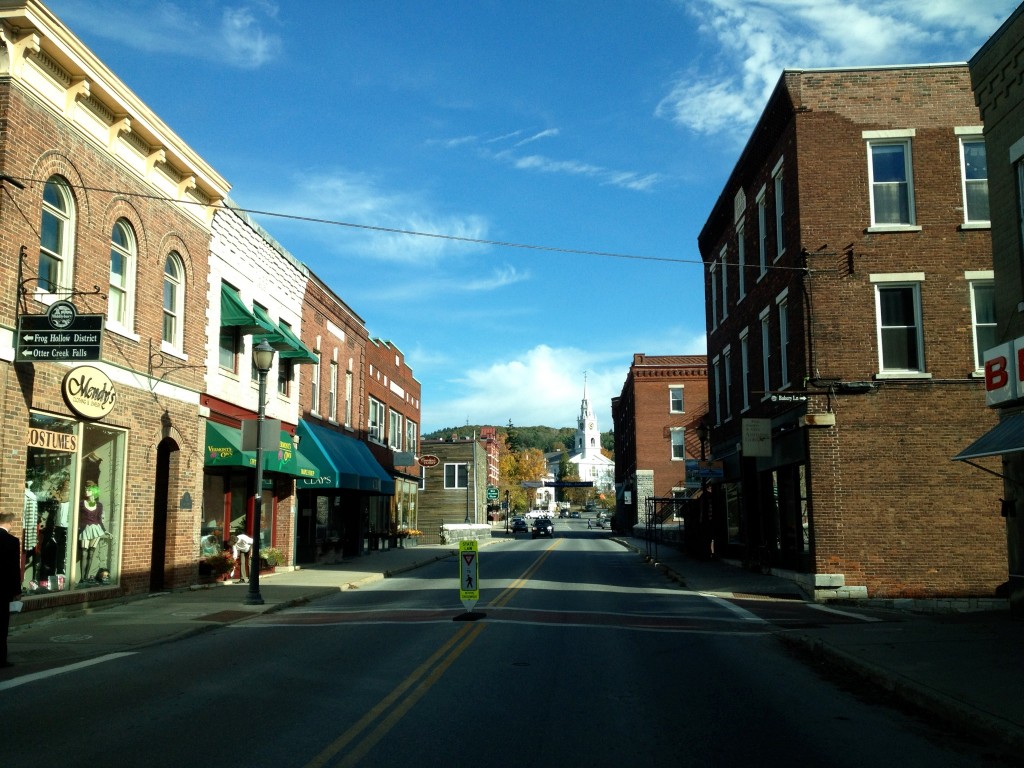
I was in a great store featuring Vermont artists when I heard a loud roar outside. I thought it was some sort of mechanical equipment, but when I stepped on to the screened back porch I realized that the shop was actually cantilevered over a waterfall in the Middlebury River.
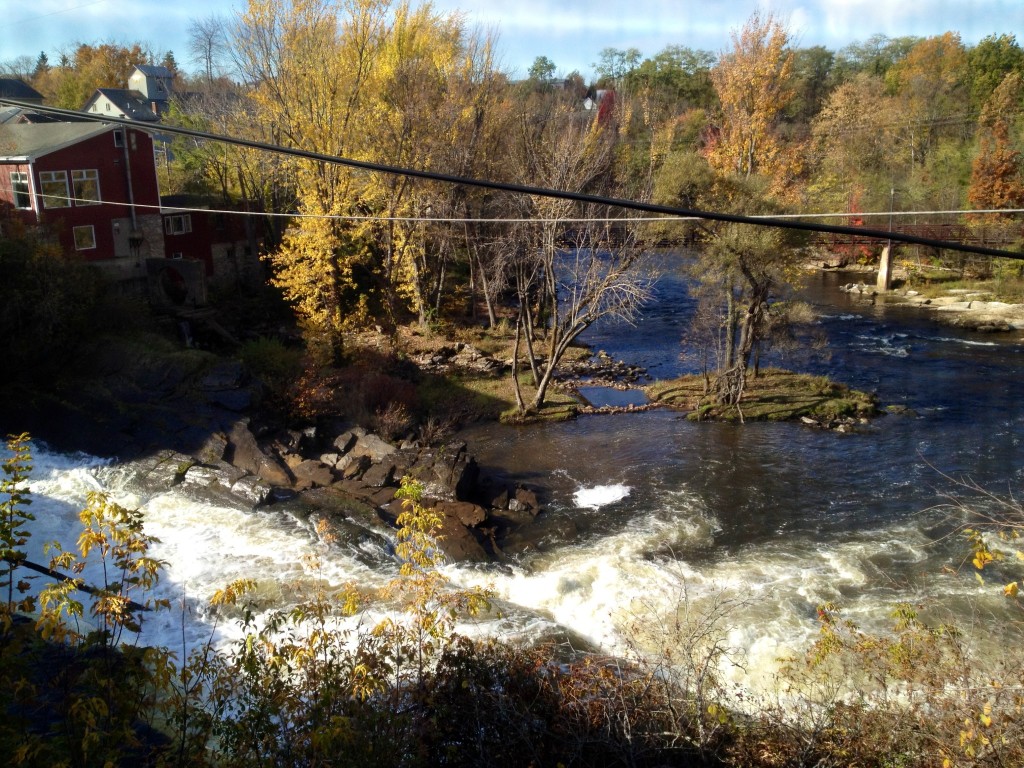
After my downtown wandering, I drove to the Middlebury College Museum of Art. I got Tucker out for a quick walk on the grounds and it didn’t take me too long to realize we’d stumbled in to the middle of a high school photography class field trip. Tuck posed by a pond for several budding artists and it gave me a kick to think his picture may be hanging on the wall for next week’s critique. Been there, done that!

The art museum, which has free admission, was showing a lovely little exhibit of original photos published in Alfred Steiglitz’s Camera Work. Camera Work, a magazine begun in 1903, was the most influential publication to elevate photography into the realm of fine art. To see images by Steiglitz, Paul Strand, Edward Steichen, and more felt like being among old friends, and it reminded me of how much I enjoy photography and how little of myself, over the past few years, I have devoted to something that used to be central to my identity. Perhaps this is a wake-up call.
From Middlebury I headed north out of town, still on Route 7. I hadn’t gotten very far until I came across Otter Creek Brewing. It was about eleven in the morning—certainly time for the first tasting flight of the day!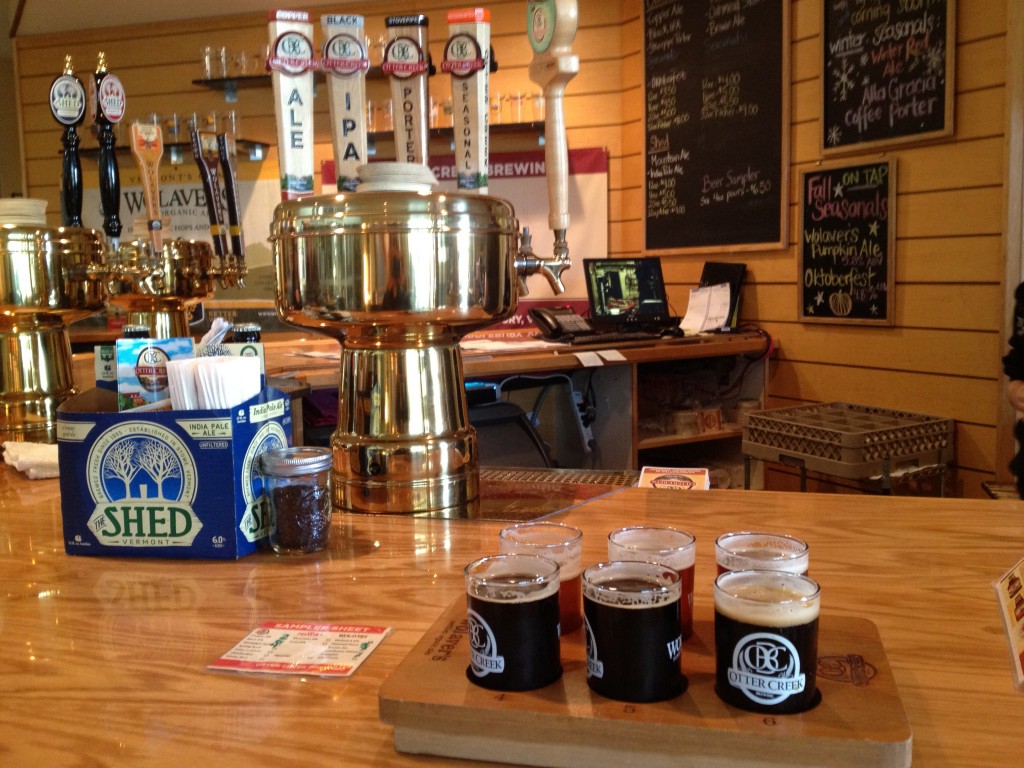
I sampled a range of offerings, from the lightest ales to the darkest stouts, and I have to admit that none really stood out to me as remarkable…which is pretty much the conclusion I’ve come to buying their beers off the shelf in Virginia. Some of the Wolaver’s Organic beers made their way in to my flight, and I found them particularly lacking. Who knew pesticides make the beer tasted good?! Nonetheless, it was a great start to my brewery tour of Vermont, and drinking at eleven in Vermont sure beats sitting at work logging in to the day’s flash sale Web sites!
I finished my breakfast sandwich while walking Tucker in the field behind the brewery, where he snuffled out some ground-dwelling creatures in the duff, and then we hit the road toward our next destination, the Shelburne Museum.
October 19th, 2012 §
On Wednesday afternoon I hit the road again headed up Route 7 through Massachusetts. The town of Sheffield was packed with intriguing-looking antique stores, but I didn’t let myself stop to browse. I was trying to conserve funds and itching to eat up some road miles. Next time…
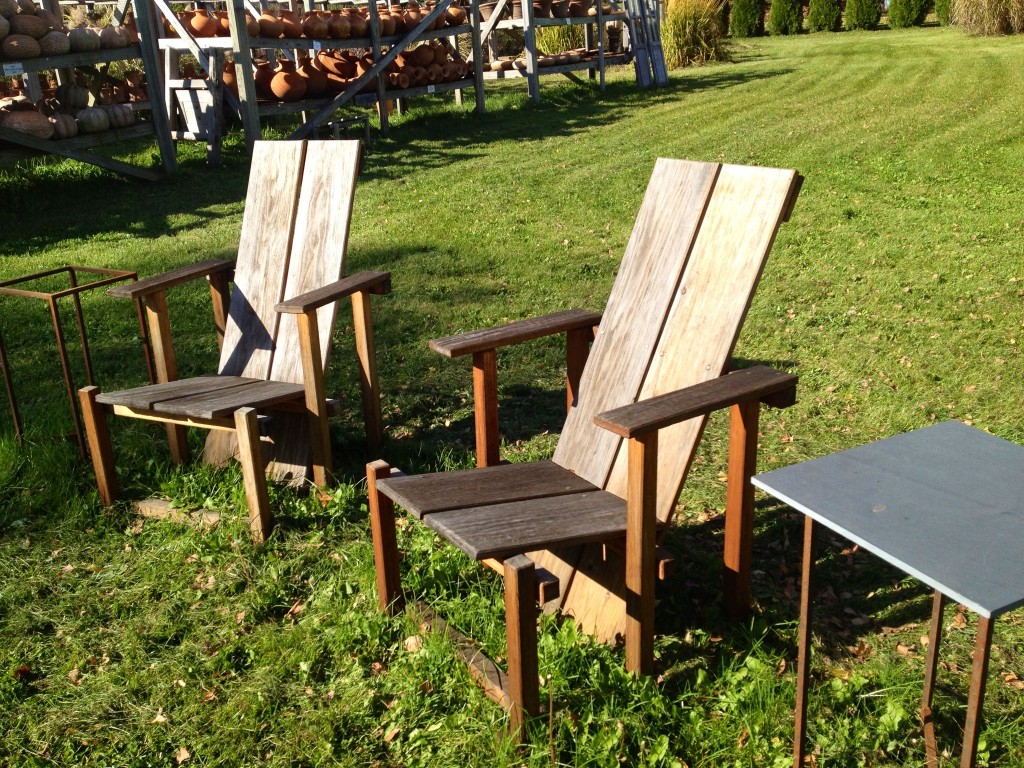
I did stop at a gardening store because I saw these chairs from the road. These look like the Wave Hill Chair, which came to my attention through one of my favorite blogs, Margaret Roach’s A Way to Garden. Read more about them here. I love the look of them, especially painted like Margaret’s are, and had always wondered if they were comfortable. After sitting a spell in one of these, I confirm they are and I would like to try making one some day. You can buy the chair plans from Wave Hill, which beats the $295 price on the chairs above!
I blew through the town of Pittsfield, Massachusetts and before I knew it I was crossing the state line into Vermont. 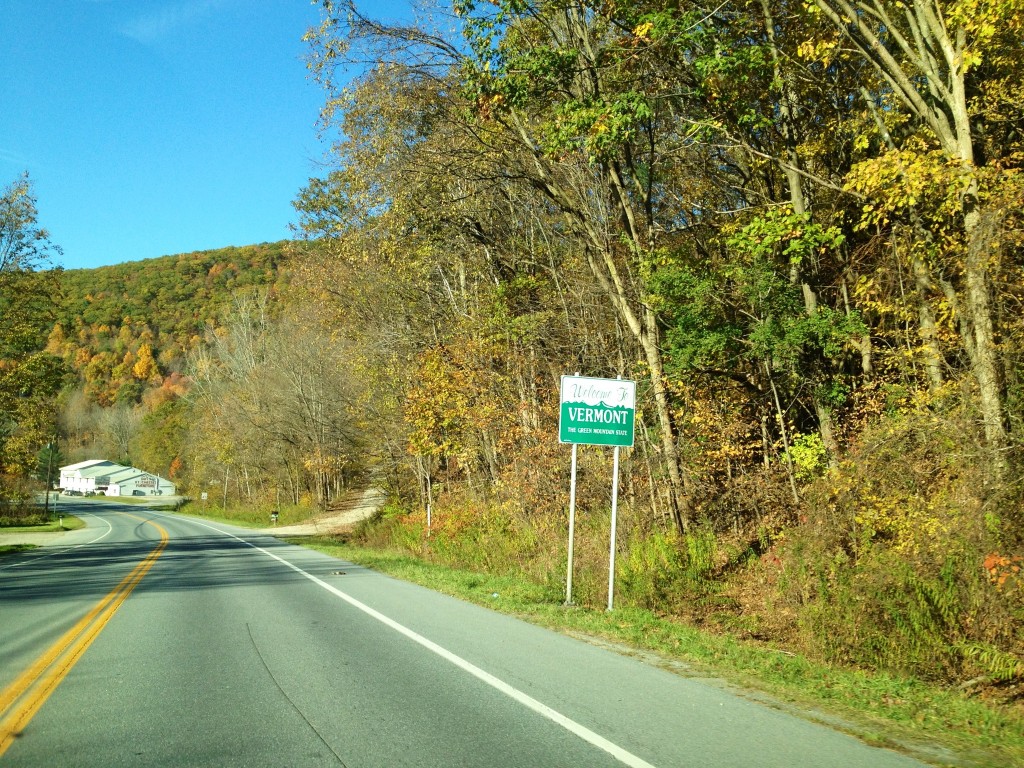
Ever since my roadripping college days I’ve dreamed of driving through Vermont. It was a dorm room crush freshman year that piqued my interest—this particular boy, who embodied the Vermont of my imagination, was a combination of exotic and practical, hardscrabble yet affable. Pure catnip. His tales of skidding his VW Bug through the snowy hills, headlights shining under the moose crossing the road, made something as simple as driving to high school sound like a manly endeavor.
Anyway, fifteen years on and I am finally in Vermont. And it’s pretty neat, just as I suspected, and full of interesting people. After the pristine Litchfield Hills, which though they are lovely felt inaccessible to a person of my means and interests, I was feeling more like these may be my kind of people—the kind who walk their sheep on a leash.
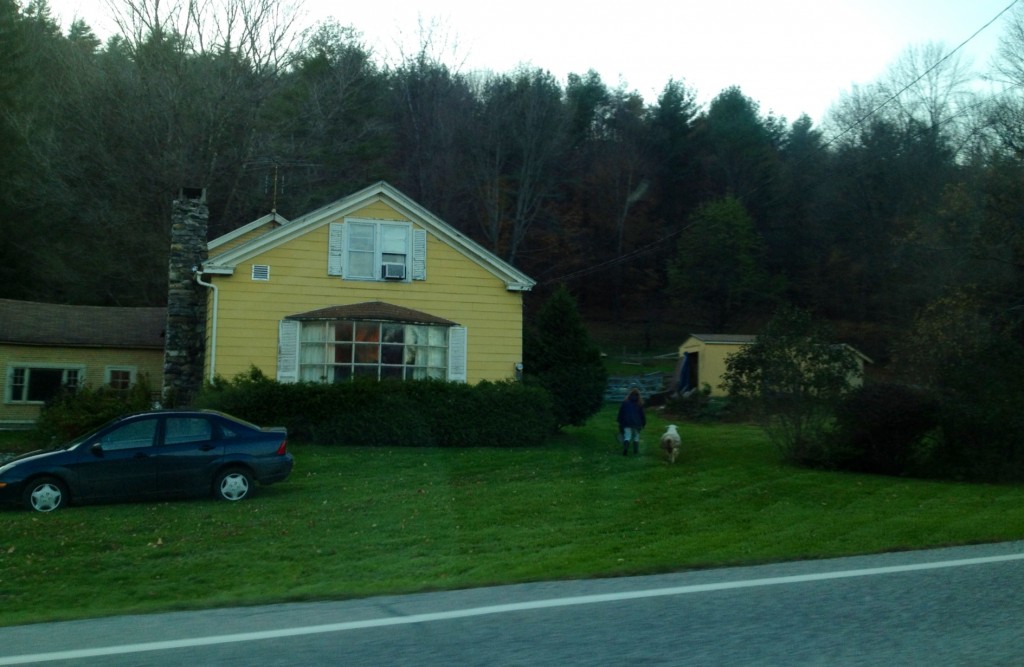
As I drove further north up Route 7, along the Green Mountains, I noticed changes outside the window. The homes took on the look of hardscrabble farms, some of them, with driveways filled with cut fire wood and roof edges lined with metal, I presume to spare the shingles from the effects of snow and ice. Certain areas looked a lot like Wasilla, Alaska, with heavy equipment, gravel pits, and tiny log cabin for sale crowded near the road.
It was dark when I pulled in to Middlebury, home of one of the nation’s oldest and most prestigious liberal arts universities, Middlebury College.
I’d managed to snag a dog-friendly hotel room at the Middlebury Inn. After checking in I walked down to the Two Brother’s Tavern, where I ordered a Vermont IPA from Fiddlehead and french onion soup.
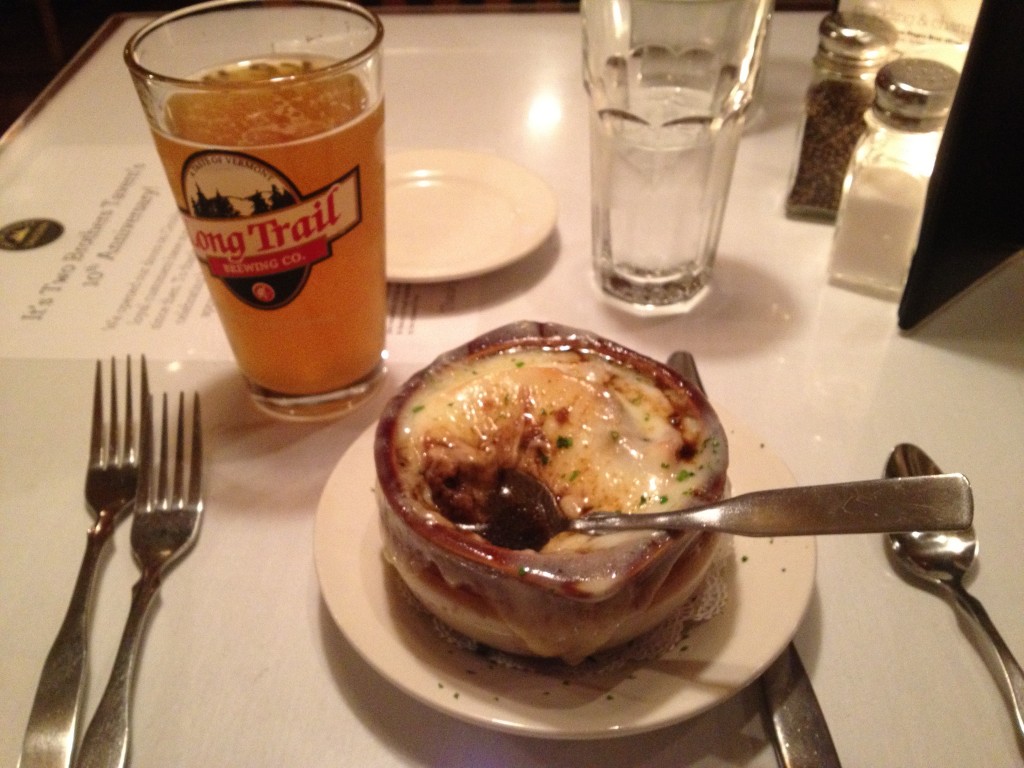
As I ate my dinner, I overheard the conversations at the tables on either side of me and felt as though I’d been dropped on a foreign planet, one of academic and emotional pretension. Exhibit A, to my right, from a stunningly beautiful afro-haired student to a Benetton ad of dining companions: “I’m doing my thesis on pleasure-centured sex ed. I may try to get into…the only human sexuality masters program in the country, but ideally I’d like to go to France.”
And Exhibit B, to my left, from a Birkenstock clog wearing lady: “It’s a political, highly charge situation, but I have a different energy that I’ve gotten to about it.” This comment seemed to depress her dining partner, so then clog woman patted her friend’s back and said, “Is this okay? You did this to me once, but I’m always afraid to do this to you because of the symmetry coming out of my arm.” The distressed friend buried her head in her hands as her dining companion removed several full-size bottles of vitamins from her bag and proceeded to take her supplements. In a restaurant.
These two tables kept me fully entertained through my main course and a nice chat with my server about foxhunting. And then I settled up and settled in at the hotel for a long, deep sleep.
On to explore Middlebury in the morning, and find out if my dinner experience was just a fluke or if the entire town really was filled with earnestly in-touch freaks.
October 18th, 2012 §
At our first stop to stay with a friend in Lake Waramaug, Connecticut, Tuck is the hit of the Hopkins Vineyard wine festival.
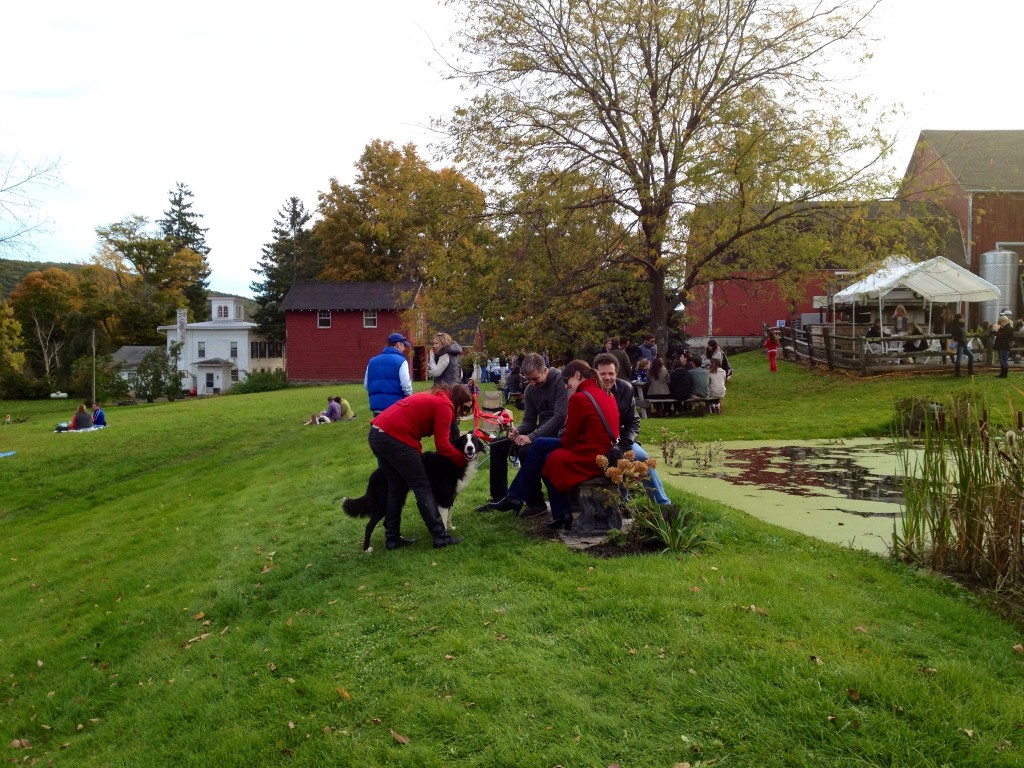
He had more people come up to greet him than ever in his life, and he did a great job as an English Shepherd breed ambassador.

Beautiful Lake Waramaug, where some of the boathouses are the size of my house.
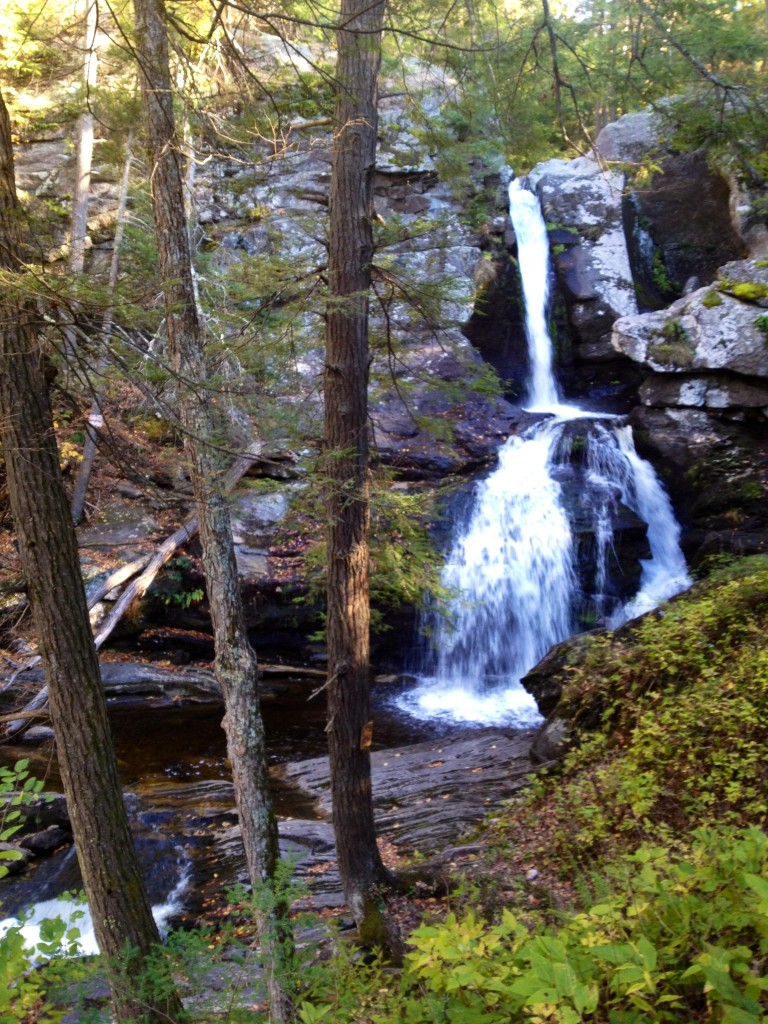
Dog hike at Kent Falls.
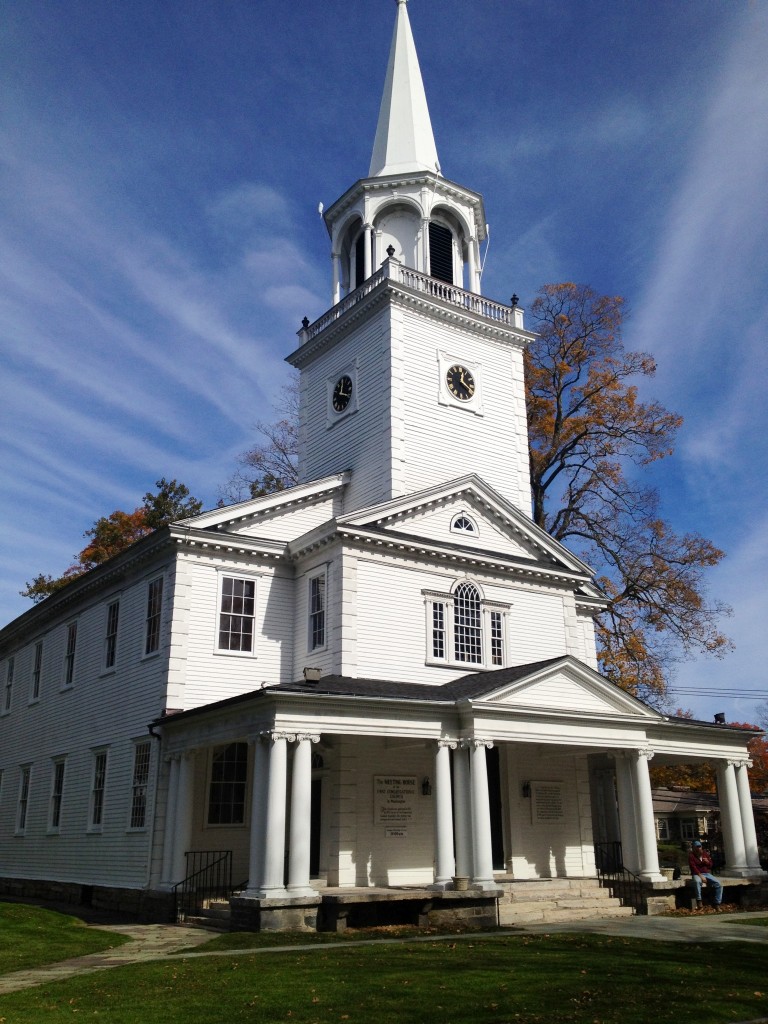
The Litchfield Hills of Connecticut are about as picturesque as you can get for a developed area. It was like the whole place was made for this time of year—even pumpkins and corn stalks look chic on the porches of classic New England homes. I imagine Halloween night or Christmas in some of these little towns, such as Kent, would provide enough seasonal cuteness that even the antichildren among us could be swayed.
Many of these properties are weekend homes for the New York City crowd…which explains why they are so well manicured and pristine. The army of contractors servicing the homes doesn’t hurt either. In one morning gardeners, generator service men, tree trimmers, and lawn mowers descended on the home next to my friend’s in a home maintenance frenzy.
I had some great food during my stay. Three trips to The White Horse Country Pub, whose branding extends even to the puff pastry horse on top of their pot pie, a few to Marty’s cafe (the classiest internet cafe I’ve ever seen), and brunch at G.W. Tavern were all delicious and had great decor. In the ladies room at G.W., someone had painted viney trees all over the William Morris wallpaper, to great effect.
Thanks to JPH and Dexter for hosting in their darling cottage and beautiful neighborhood. You’ve done it again with finding an awesome place to live!
October 17th, 2012 §
The Bonafide Farmer and her farm dog are on the move! Tucker and I are road tripping through New England. We spent the last few days in Connecticut and are now in Vermont, a state that I as of today get to check off my visited list—a lifelong dream come true. More to come as I figure out Wordpress’ mobile app…

Frosty morning hike in the beautiful Delaware Water Gap in the Pocono Mountains.
September 27th, 2012 §
I didn’t think many people would want to start their day watching eight live chickens be “harvested” and processed, but the conference room for the 10:00 a.m. “Pluck A Lotta Chickens” live demonstration was standing room only way before the presentation began. There must have been 500 or more people there to learn how to slaughter and butcher chickens.
David Schafer, the very easy-on-the-eyes creator of the Featherman line of poultry processing equipment, and Joel Salatin, our previously mentioned hero of the grass farming movement, stood at the front of the room and introduced us to the morning’s teachers: four Cornish crosses and four Freedom Rangers that had been lovingly reared by a nearby farmer, in the green shirt below, and his family. The birds were big and glossy and gorgeous, a far cry from the half-dead creatures I saw yesterday on the road.
After David and Joel took a moment to acknowledge the birds for their lives and their caretaker for his work raising them, David placed the birds one-by-one, head down, in a wheel of metal cones. He gently extended their heads and carefully sliced the artery right under their jawbones. The blood dropped out of the birds in a gush as they calmly blinked a few times, losing blood pressure.
In a minute or so rigor mortis set in and the birds, which were no longer conscious, flapped wildly in their cones. David let the birds continue to bleed out for a few minutes more before putting them in a rotating scalder.
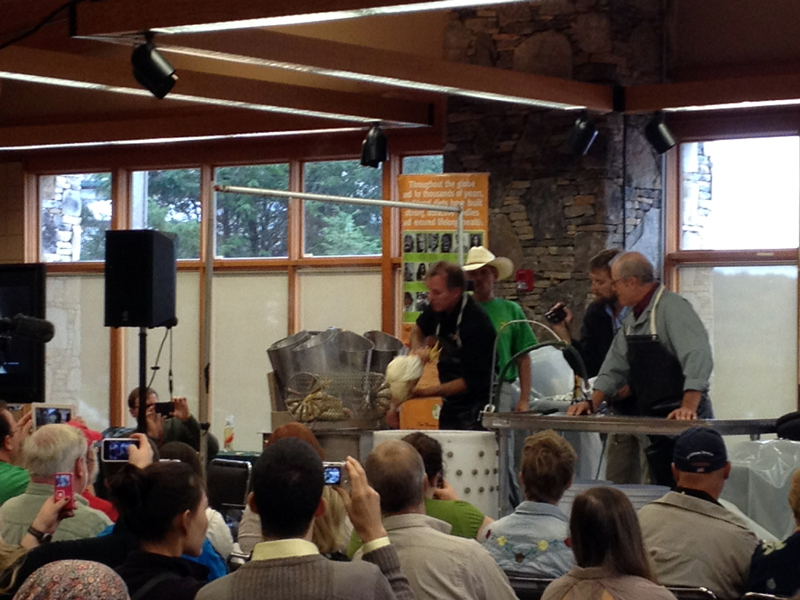
From there he put the birds in a feather plucking machine that bobbled them around until their feathers were rubbed off by rubber fingers. Then Joel took over with the butchering.
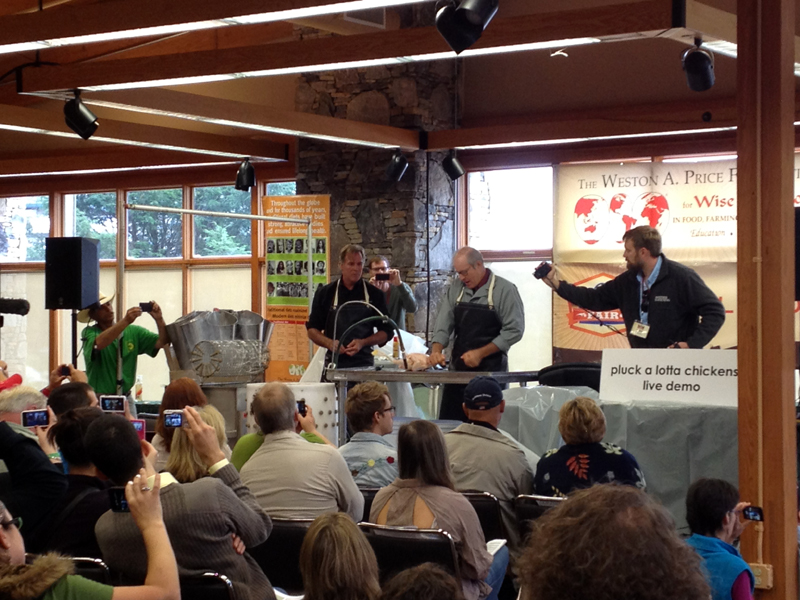
First, he pulled the head off the bird, above, a movement that surprised me by its ease. It was a bit shocking to me how easily the head came away from the body, especially after having worked so hard to keep a head attached to one of my own birds. Then Joel cut off the feet and the oil gland above the tail.
He then made a small incision in the front of the bird to access the windpipe and crop, which he loosened by scooping his fingers under it—taking a moment to remind us to fast our birds for a day before slaughter to make this process cleaner. Then he made another incision at the back of the bird around the vent and was able to pull all the viscera out with one hand. A quick tuck of the legs into a slit in the chicken’s skin and it was ready for an ice-water bath. Joel told us that when racing, he could process a chicken in 20 seconds. Wow.
The best part of the demo was how easy it looked. I’d always been a bit intimidated at the thought of butchering a chicken, anticipating a horrible bloody mess and suffering creature, but after watching these teachers—who are the most famous in the business—I think I could do it. Who knows, maybe next year will find me raising a bunch of Freedom Rangers for my freezer!
After this session I wandered over to Christy Hemenway’s talk about keeping bees in top bar hives, which look like a child’s coffin on legs. Christy runs Gold Star Honeybees in Maine and wrote “The Thinking Beekeeper.” I’ve been dancing around the idea of keeping bees for a couple of years, and have even joined the Central Virginia Beekeeping Association. But after a few meetings and a workshop I started to think that the odds are stacked against the beekeeper. Between big predators, such as bears, and tiny marauders, such as the varoa mite, I had grown disheartened even before setting up a hive and decided beekeeping was a fool’s game.
Top bar beekeeping, though, just might change my mind. In a top bar hive, bees build their own wax combs suspended from narrow wooden bars instead of colonizing premade wax foundations, which are often made from beeswax that’s been treated with pesticides to kill varoa mites. Not exactly something you’d want to eat. And when bees build their own combs, they actually build cells of a size that can’t accommodate the varoa mite. It’s a bit more of a production to extract honey from combs built in top bar hives, but the health of the bees in such a system would more than make up for the inconvenience.
After the bee talk I got some lunch. Strangely enough I went for the chicken kabobs…and noticed while in line that my choice of outfit was well-aligned with other festival goers.
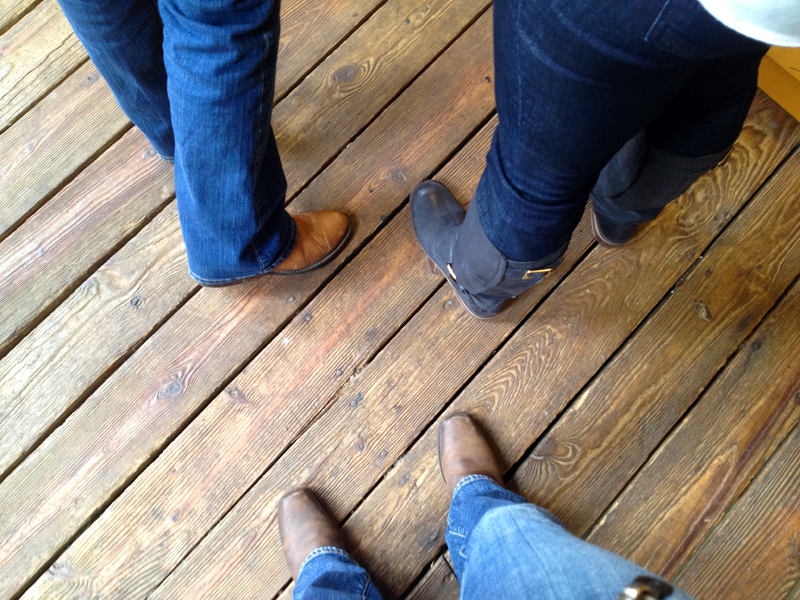
Then on to hear Patricia Foreman talk about gardening with chickens. I’d seen Patricia speak the weekend before at the Heritage Harvest Festival, and her talk was pretty similar to what I’d heard there. She advocates putting our chickens to work creating compost. As the cost of feed is increasing, and my flock size grew this summer, I was all ears. The idea I took away from this talk was that I’d like to turn my chickens out into my garden once everything freezes. I hope that they will till up the dirt and in addition to fertilizing eat all the insect eggs that are plaguing my gardening life. I’d also like to figure out how to build a chicken tractor that can detach from my coop and be moved around the yard, instead of building a permanent run.
Next up was a talk by Jenna Woginrich, of Cold Antler Farm, about how she makes her living blogging and writing. Jenna is an enthusiastic and natural speaker who kept her audience laughing. As I suspected I would be, I was even more inspired by her in person than I’ve been from years of reading her blog. Jenna boiled her success down to a combination of flexibility and stubbornness—necessary traits, she claims, for the self-employed. I admire Jenna for bucking convention and being one to say no thanks to a society that trains us to, “be scared to do what we want to do.” And we don’t need to have all the answers before we start something new—the important thing is to just begin. As she says, “You can drive to L.A. in the dark. Your headlights will get you there 200 feet at a time.”
I stuck around in the same meeting room for the next talk by Wisconsin farmer Ann Larkin Hansen. I’d heard her speak for a few minutes the day before on woodlot management, but her next presentation was on making hay. I wanted to figure out when was the best time to cut hay for optimum nutritional content, and Ann told us the legumes are the key to when to cut. You should make hay when the legumes have grown as tall as they are going to get and are starting to bud and the grasses are just starting to develop their heads. As crops grow taller, beyond this point, the quantity of your hay increases but its nutritional quality decreases. Leave 2-3″ of stubble in the field when you cut to help prop the hay off the ground, which makes it dry faster. Dry hay is key. Wet hay, if baled, can compost and selfcombust and burn down your barn. Not cool. Ann then got into haying machinery and I slipped out to meet Jenna at her booksigning.
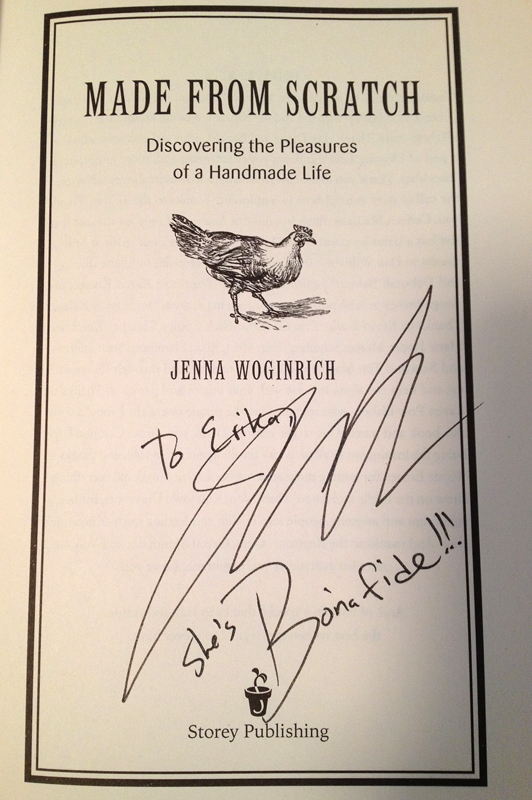
As hoped, I got to talk with her for a few minutes and tell her a bit about my farm. I bought all her books and she signed them for me before she had to run out to give her keynote, which highlighted the importance of community to any farming endeavor. Certainly true, especially for single farmers such as Jenna and myself!
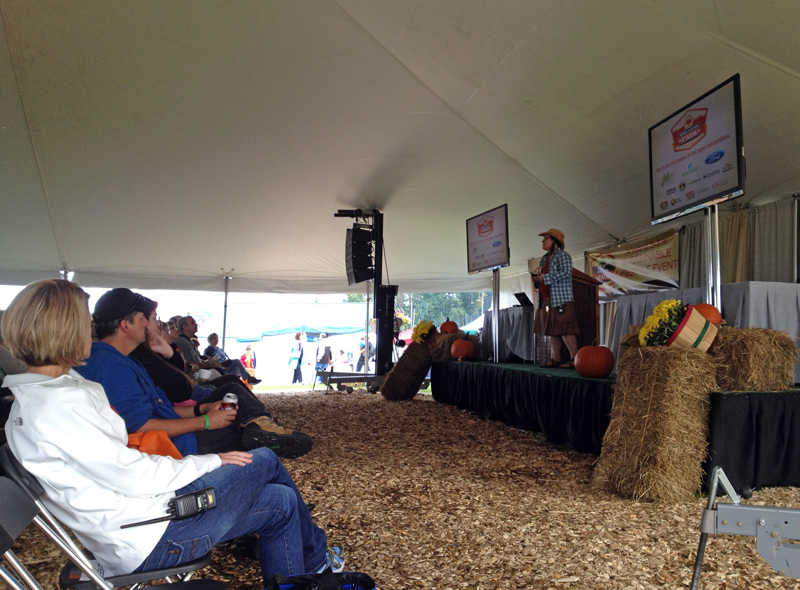
And then day two of the fair came to a close and I retired to dinner and a wonderful hotel sleep. I always sleep well in hotels—I think the secret lies in blackout curtains!
Stay tuned for day three, in which we learn about heritage goats and “make friends with our kombucha!”















































